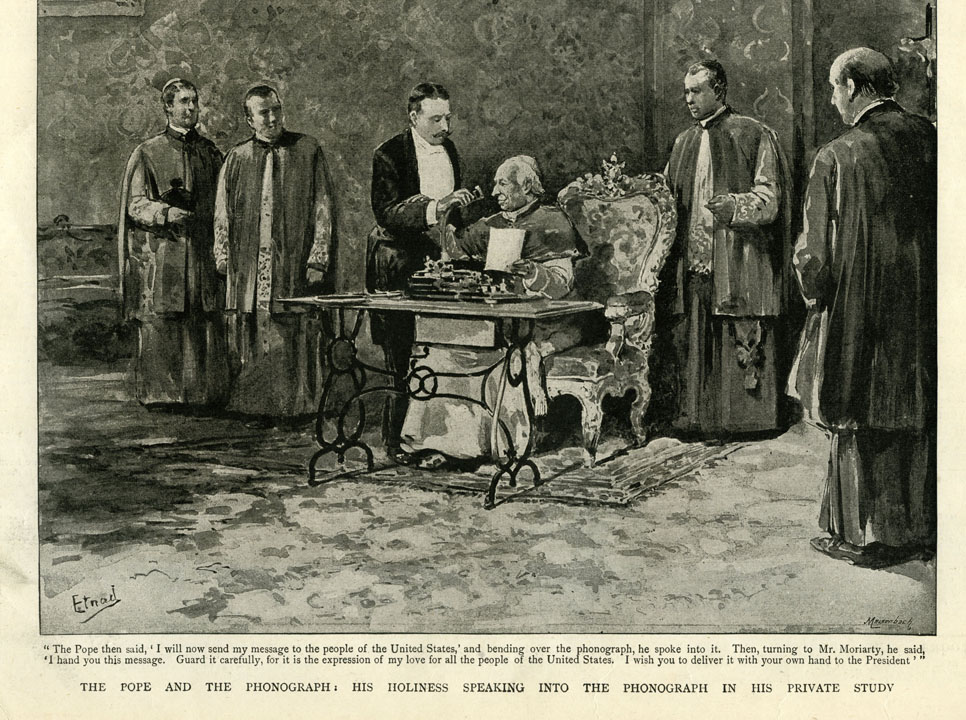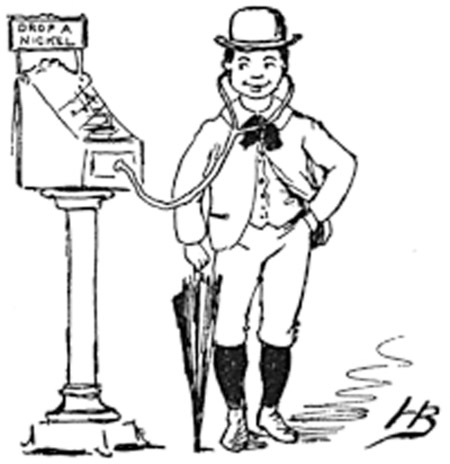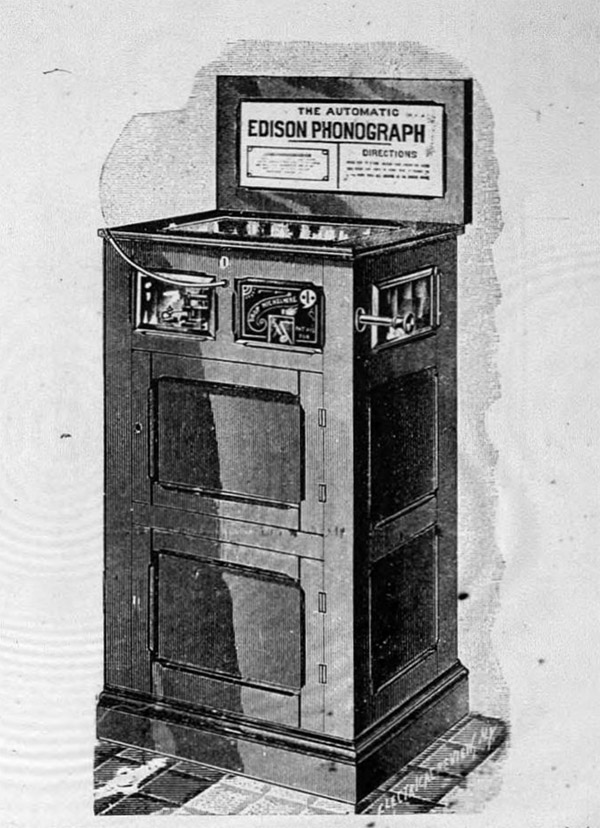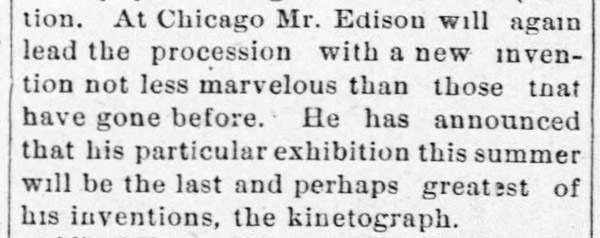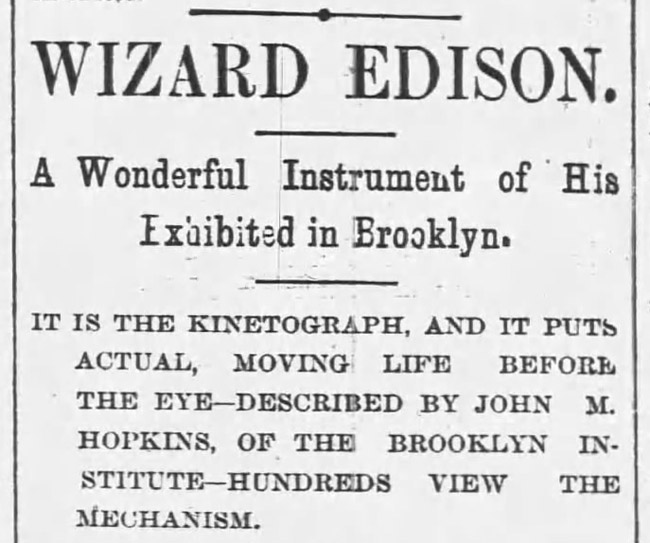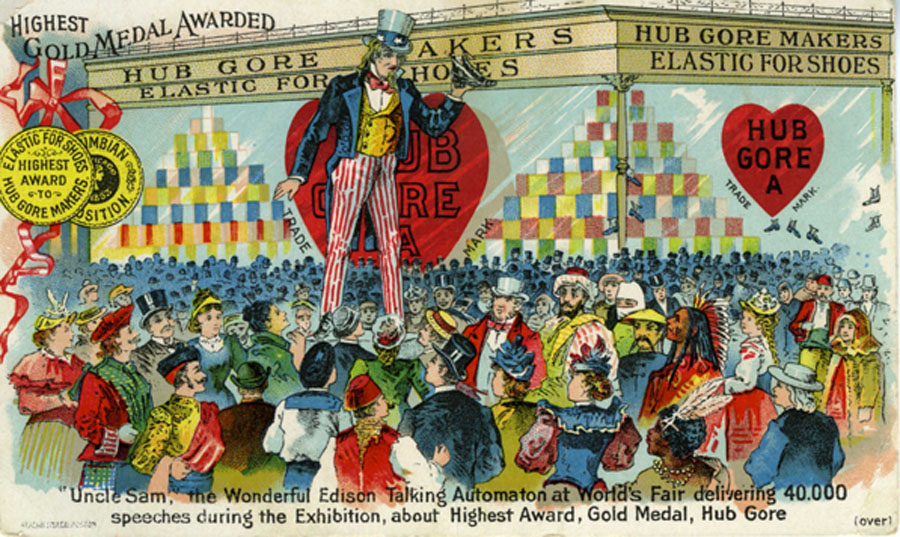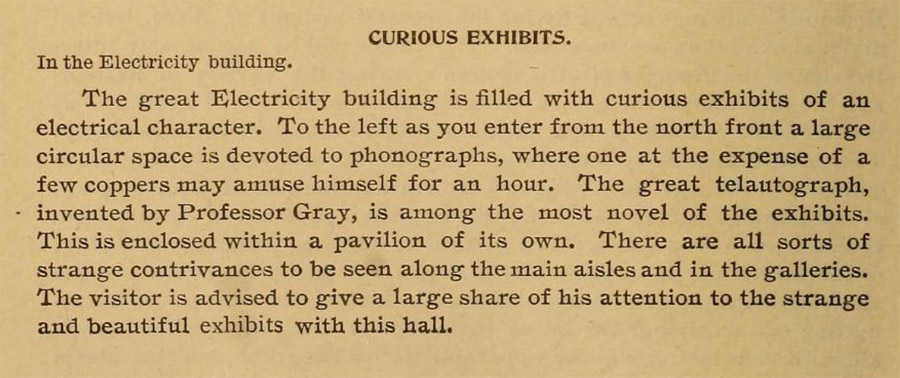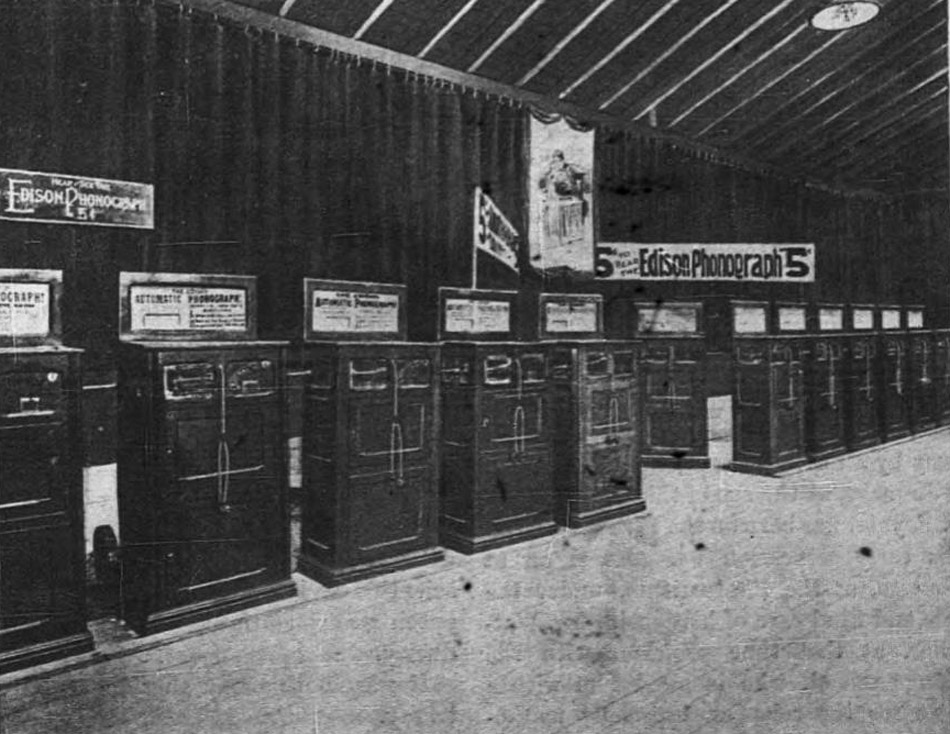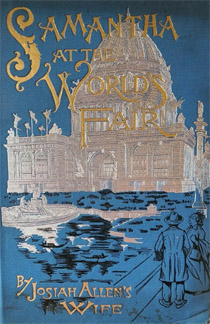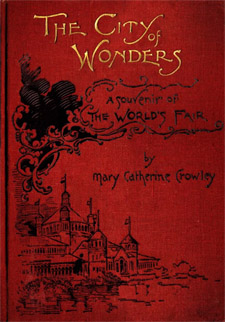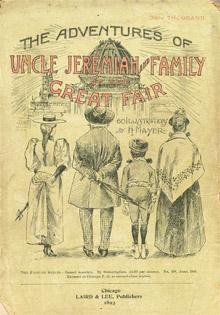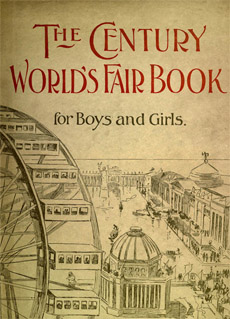The World's Columbian
Exposition of 1893 and the Phonograph
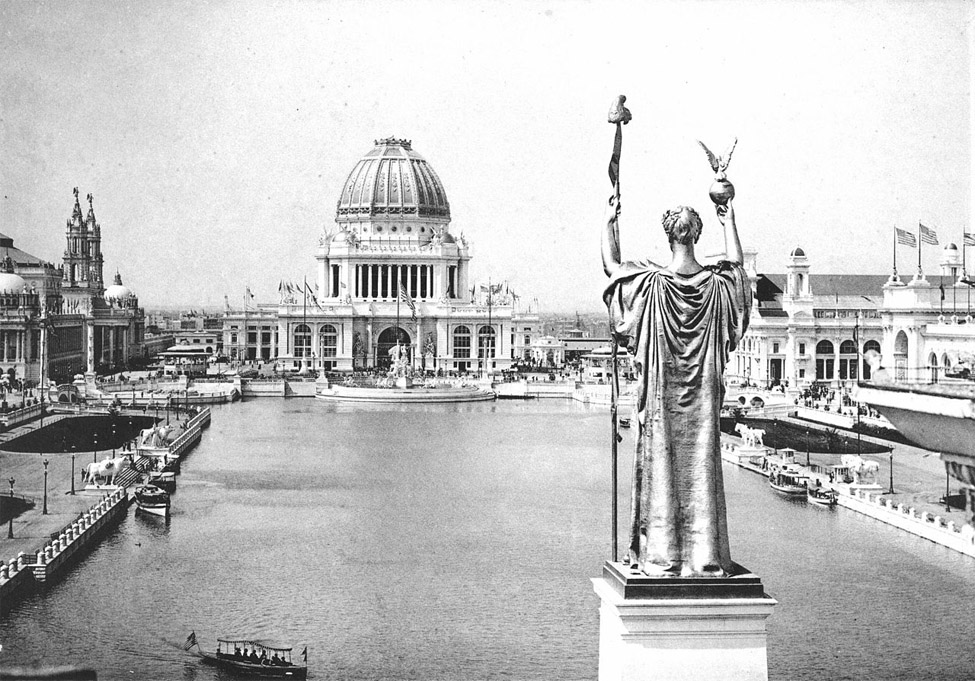
Looking West From Peristyle, Court of
Honor and Grand Basin of the 1893 World's Columbian Exposition
By Doug Boilesen, 2021
The World's Columbian Exposition was
a world's fair held in Chicago
in 1893 to celebrate the 400th anniversary of Christopher Columbus'
arrival in the New World in 1492. "The exposition was an influential
social and cultural event and had a profound effect on architecture,
sanitation, the arts, Chicago's self-image, and American industrial
optimism." (1)
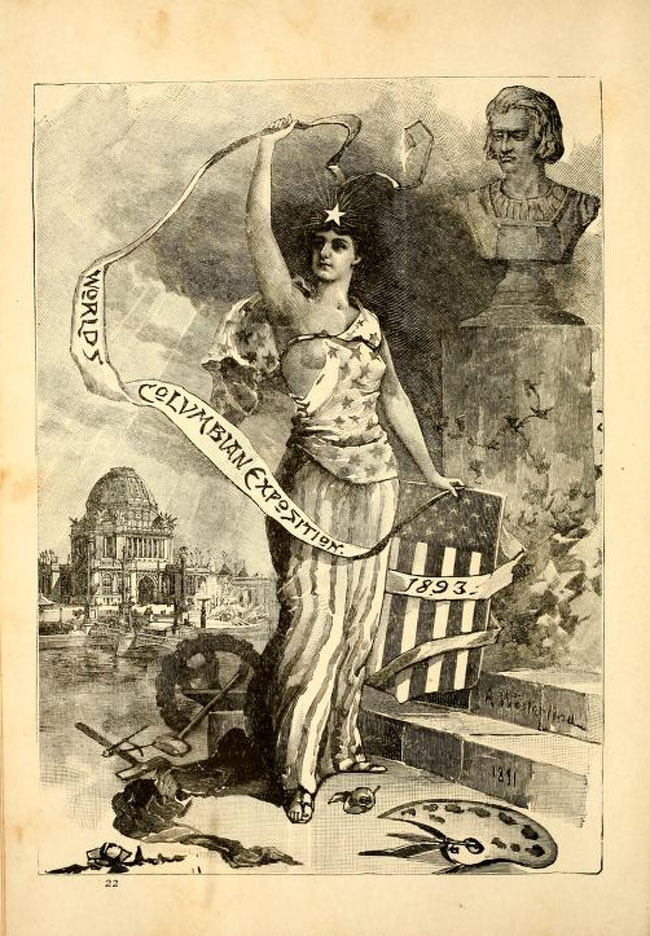
The World's Fair,
Being a Pictorial History of The Columbian Exposition, P. D.
Farrell & Co., 1893, p.22
Edison had demonstrated his phonograph
and electric lights at the Exposition
Universelle of 1889 in Paris to crowds filled with wonder and
admiration for those inventions.
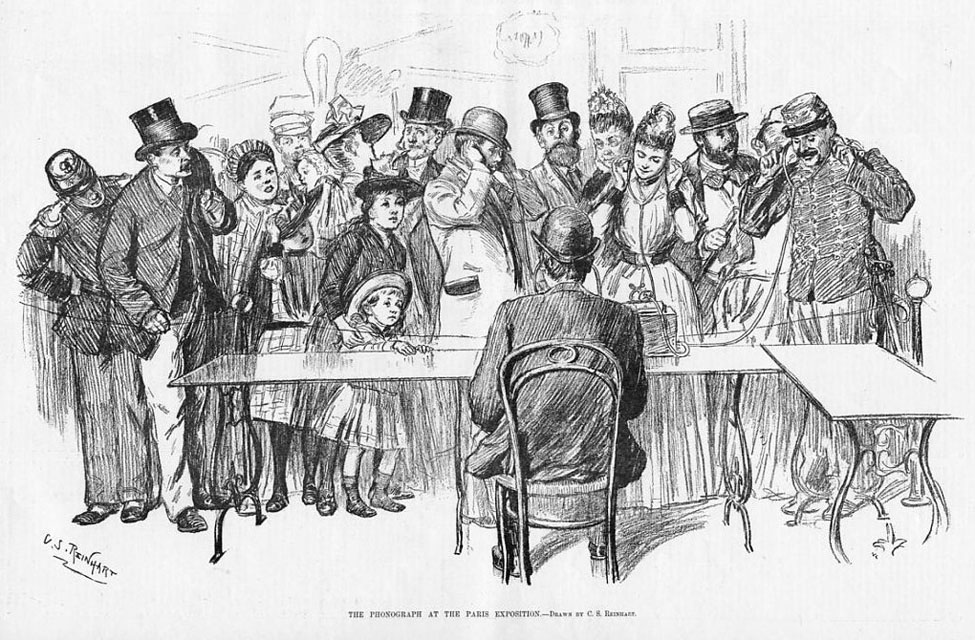
The Phonograph at the
Exposition Universelle of 1889 in Paris,
Harper's Weekly, June 1889
The Chicago World's Fair, however,
wasn't the Paris experience that Edison had enjoyed in1889. The
adulation for Edison's light bulb in Paris was now dimmed by the
alternating power system used to illuminate more than 100,000 lamps
at the Chicago fair's "White City" in 1893. Those lights
belonged to George Westinghouse who had underbid Edison and General
Electric's direct current (DC) system to secure the fair's contract
with his alternating current (AC) power system. The spectacle of
the lights witnessed by tens of thousands on the fair grounds every
night literally showcased the future of alternating current for
cities and homes around the world. (Watch 2016 promo for PBS
American Experience - The Columbian Exposition from Tesla).
The phonograph had enjoyed much attention
in Paris and Edison did highlight his 1893 phonograph in Chicago
with countless fair-goers hearing its music and the entertainment
that it provided. Edison's "domestic" phonographs and
residence outfits were being offered in 1893 but its price was still
a major hindrance for the home market. Nevertheless,
for the phonograph industry the World's Fair was an opportunity
to promote the phonograph as improved and ready for use in business,
education, coin-in-the-slot amusement and home entertainment.
The "Stationary Exhibition
Outfit, to be operated by coin-in-the-slot mechanism for reproducing
only. Phonograph complete with electric motor and hardwood cabinet."
The Phonogram, January 1893.
FACTOLA: The push-bar
(to activate the coin insert) was eventually discarded because
people either hung their hats on it, or small children used it
as a trapeze bar. The improved version had a small crank
which was "close" to the case (horizontal) and did not
project so much. Those serial #'s began much higher, generally
#750." - Allen Koenigsberg via correspondence).
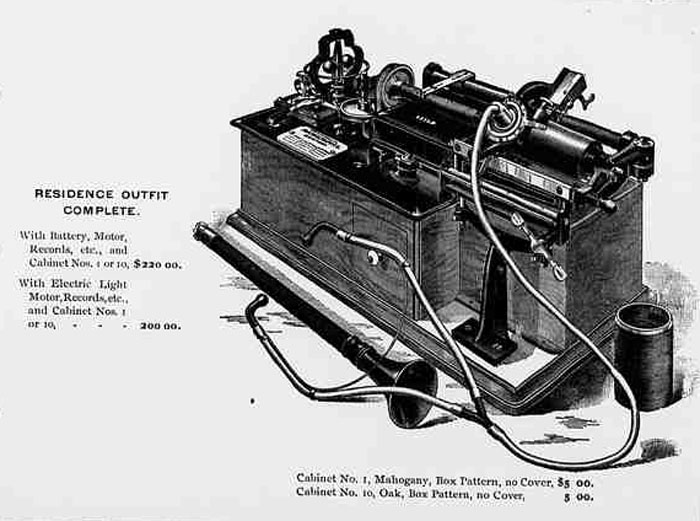
North American
Phonograph Company - 1893
brochure showing Edison Phonograph "Residence Outfit"
- (The Thomas
Edison Papers, Rutgers)
The Name and Fame
of Edison
Many articles about Edison and his
exhibits for the World's Columbian Exposition of 1893 started by
mentioning his accolades as Wizard and genius inventor.
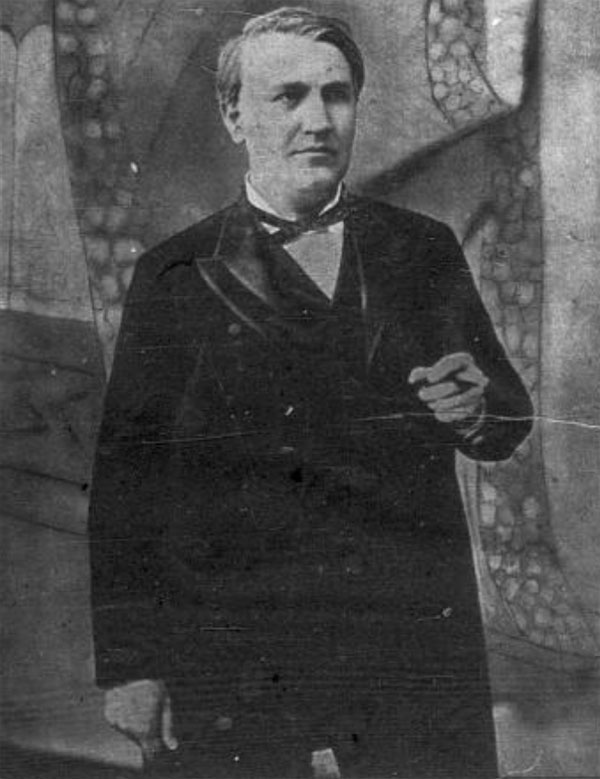
Thos. A. Edison, President
of the North American Phonograph Co.
"We presume among the millions
of visitors to the Columbian Exposition there will scarce be one
unacquainted with the name and fame of thomas A. Edison.
"The mental energies of
the great inventor seem to have been unremittingly applied to
the problem of how best to lighten the labors of toilers. To this
end he studies the introaction of nature's forces, making these
his agents to cause movements in inert matter that accomplish
what man alone has not the physical power to effect." --
The Phonogram, March
and April, 1893, p. 380.
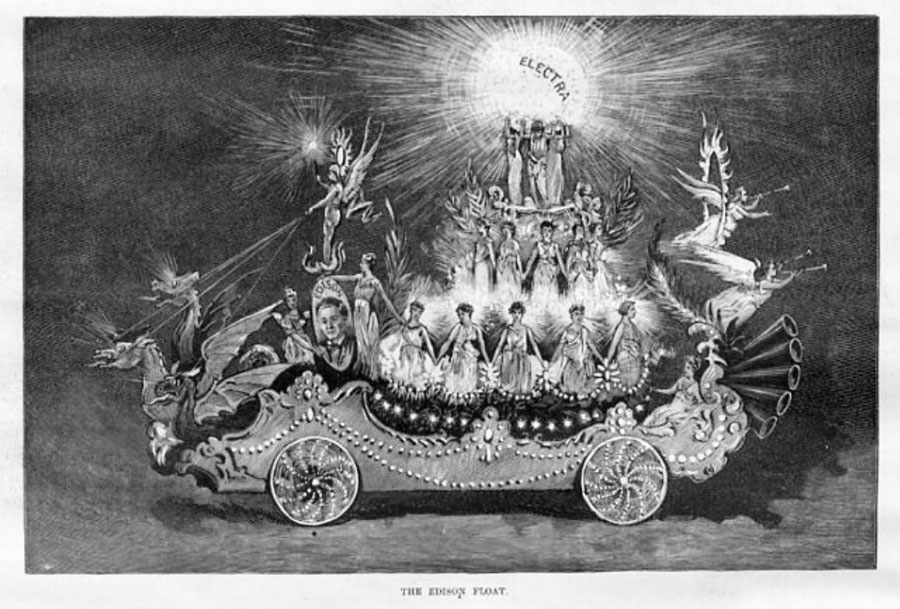
The Edison Float
at the New York Columbian Celebration, Harper's Weekly,
October 1892
Expectations for
Edison's Newest Wonder - The Kinetograph
His phonograph and other electricity
system components and domestic appliances were promoted as upcoming
exhibits for the World's Fair. But as America's greatest inventor
there was an expectation that Edison was always working on a new
wonder or perfecting a previous one.
True to form in July 1891 the Chicago
Tribune wrote that Edison was working on perfecting his kinetograph
which he will "complete
in all its details" by the time of the opening of the world's
fair in 1893 where he would then exhibit his device which would
"do for the eye what the phonograph does for the ear."
Two years later, as the May 1, 1893
opening date of the fair approached, large and small newspapers
across the country were still reminding readers that Mr. Edison
will again lead the procession at Chicago with a new marvel, "perhaps
the "greatest of his inventions, the kinetograph."
The World's Columbian Exposition
of 1893 and the Phonograph
The following scrapbook features Edison's
exhibits at the Chicago World's Fair with particular attention to
the phonograph.
A number of stories in newspapers
and books include references to visitors of the fair listening to
the phonograph. Some exhibitors even used the phonograph for special
effects such as the Bernese
Alps Cyclorama on the Midway Plaisance where a phonograph record
in their cycloramic show made "the deception complete, as one's
ears are greeted with the strains of a Swiss ballad seeming to proceed
from the maid." Located on the Midway going East on the Southside
of the street the Bernese Alps Cyclorama could be seen for 50 cents.
An Edison phonograph
was used for an automaton of Uncle Sam to "talk" and deliver
his recorded speech promoting Hub
Gore Shoes.
And it would also be the phonograph
that was supposed to be part of Edison's "special exhibit."
When the Official Guide to the Chicago World's Fair was published
(prior to the fair opening) Edison's kinetograph was identified
as "among the most unique exhibits" of the fair.
This new kinetograph was said to work in conjunction with the phonograph
so that it "transmits scenes to the eye as well as sounds
to the ear."

The Official Guide
of the World's Columbian Exhibition, April 1893 (published before
the fair opened)
There is little evidence, however,
that the kinetograph was ever at the World's Columbian Exposition
of 1893, and definitely not as a coin-in-the-slot device which could
entertain visitors with moving pictures and sound.
Edison's Kinetograph
at the 1893 World's Fair, therefore, has its own page to tell
that story since Edison, newspapers, pre-fair publicity, guidebooks
and the public were all expecting the kinetograph to be at the fair.
Edison the Wizard and the Electricity
Building
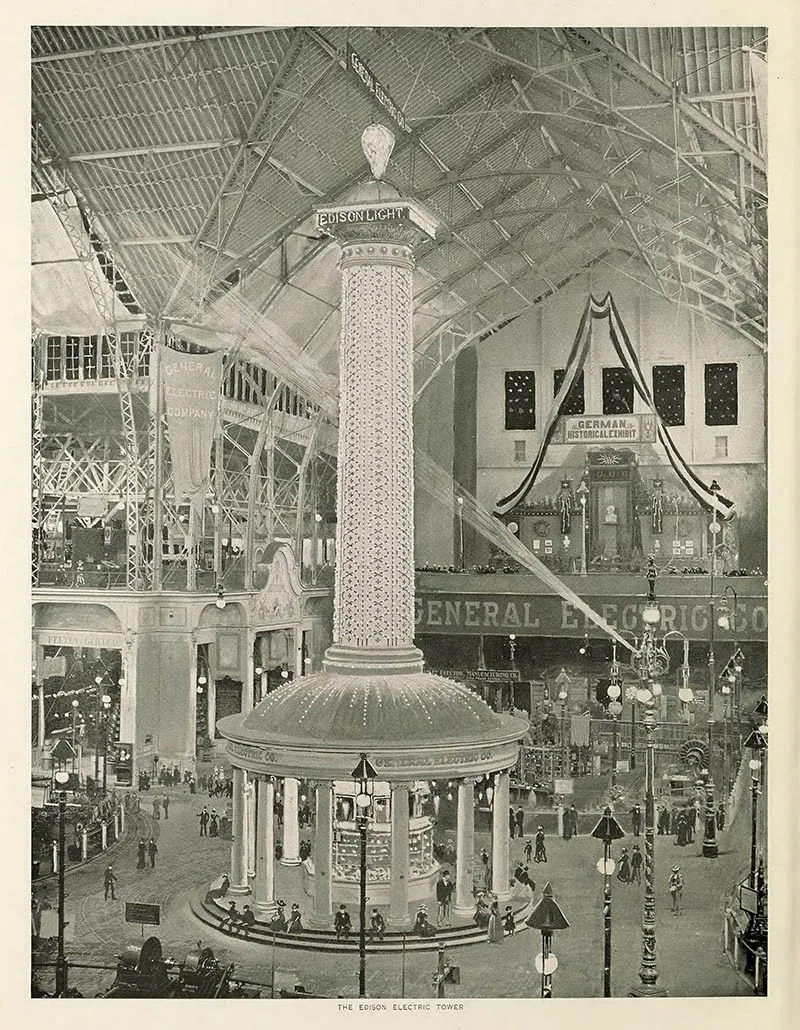
The Edison Tower image
from Bancroft, Hubert Howe The Book of the Fair. The Bancroft
Company, 1893.
The Edison Tower of Light in the General
Electric exhibit in the Electricity Building had an eight-foot tall
light bulb at the top. "A pillar built with a million jewels"
as Nora Barrett described it in The
City of Wonders.
Standing inside the Electricity Building
and seeing the "Edison Electric Tower" a.k.a. the "Tower
of Light" was a reminder that Edison was the Wizard and the
light bulb was his "crowning achievement." However, it
was also a reminder that only a year earlier the Edison General
Electric Company had been acquired and was now General Electric.
Edison's name was gone and the signage "Edison Light"
on the electric tower was topped with the "General Electric
Co.".
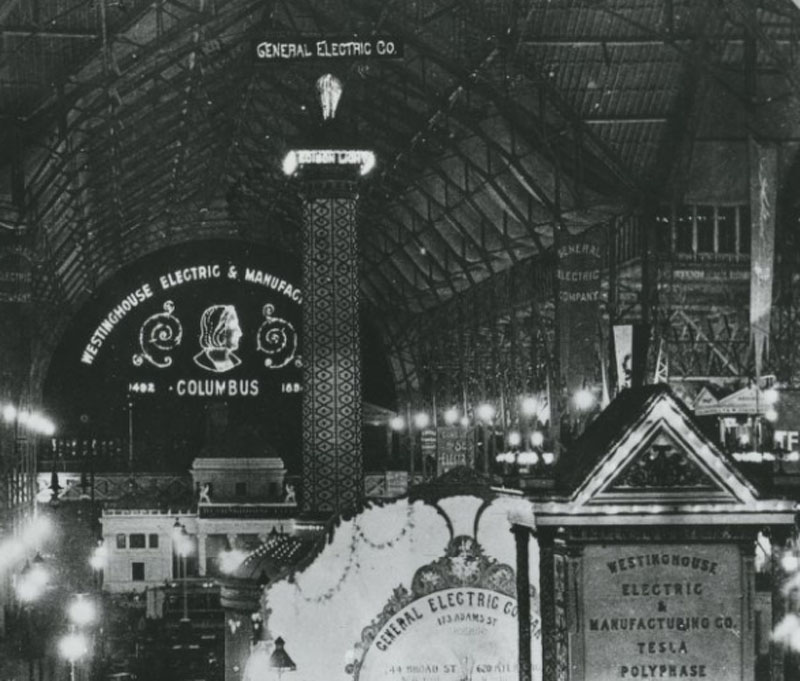
EDISON LIGHT signage
topped by GENERAL ELECTRIC CO. signage
For an illustration of the tower by
R. Outcault and other views of the tower and fair see The
Edison Electric Tower.
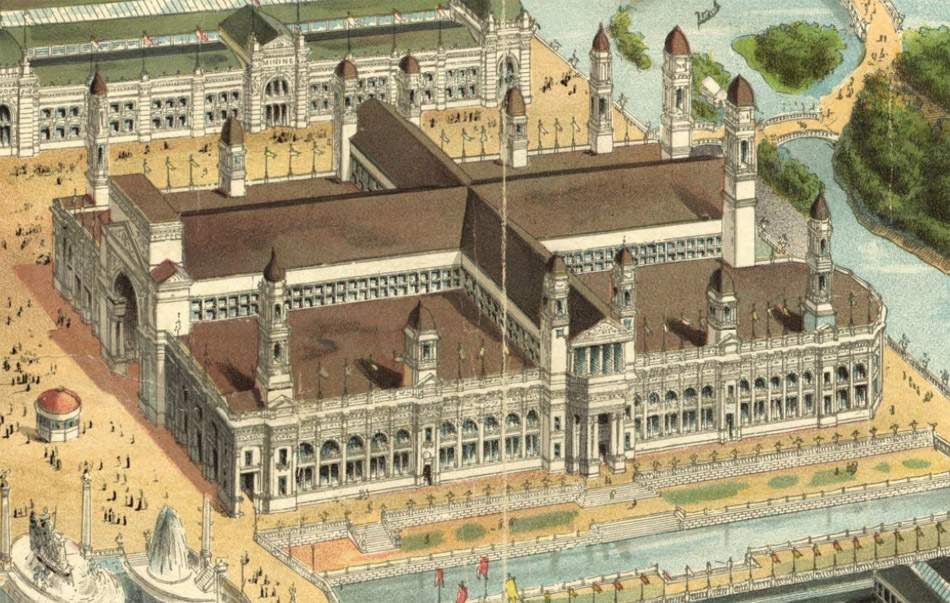
From a Bird's
eye view of the Electricity Building, Rand McNally and Company,
1893 (Courtesy Library of Congress)
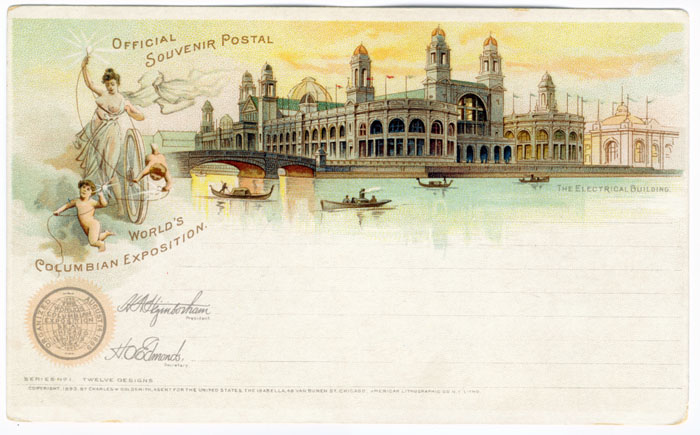
Official Souvenir Postal
World's Columbia Exposition featuring The Electrical Building. (Courtesy
The
Chicago Postcard Museum.org). Visit The on-line Chicago
Postcard Museum to "see the complete set of 12 (series
No. 1) Official 1893 Chicago World's Columbian Exposition postal
cards that include the one cent postage. These are the first commercially
produced postcards to be sold to the general public at the Fair.
Published by the American Lithographic Company, New York."
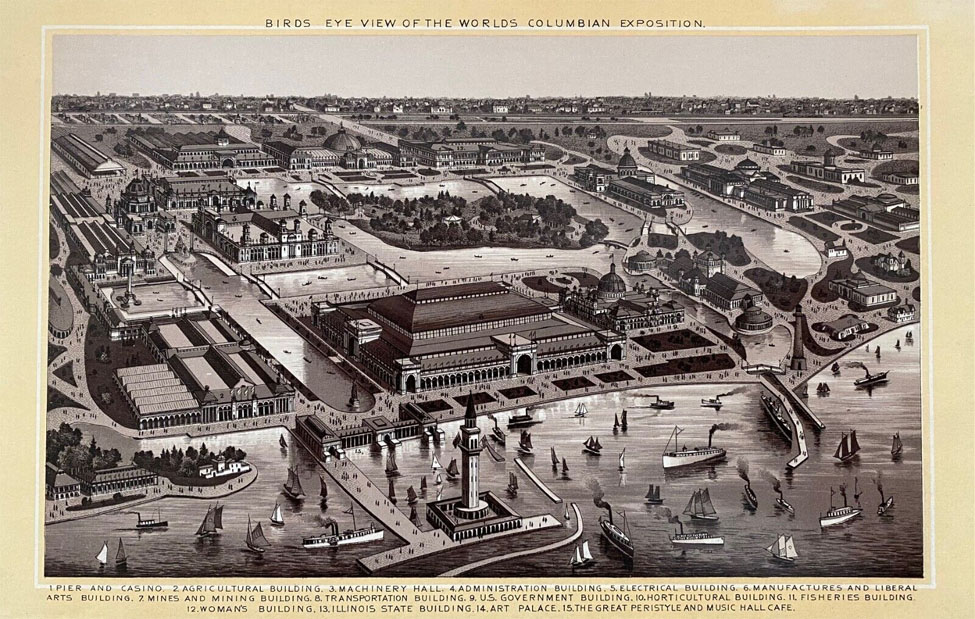
Bird's Eye View - The
World's Fair Album of Chicago 1893
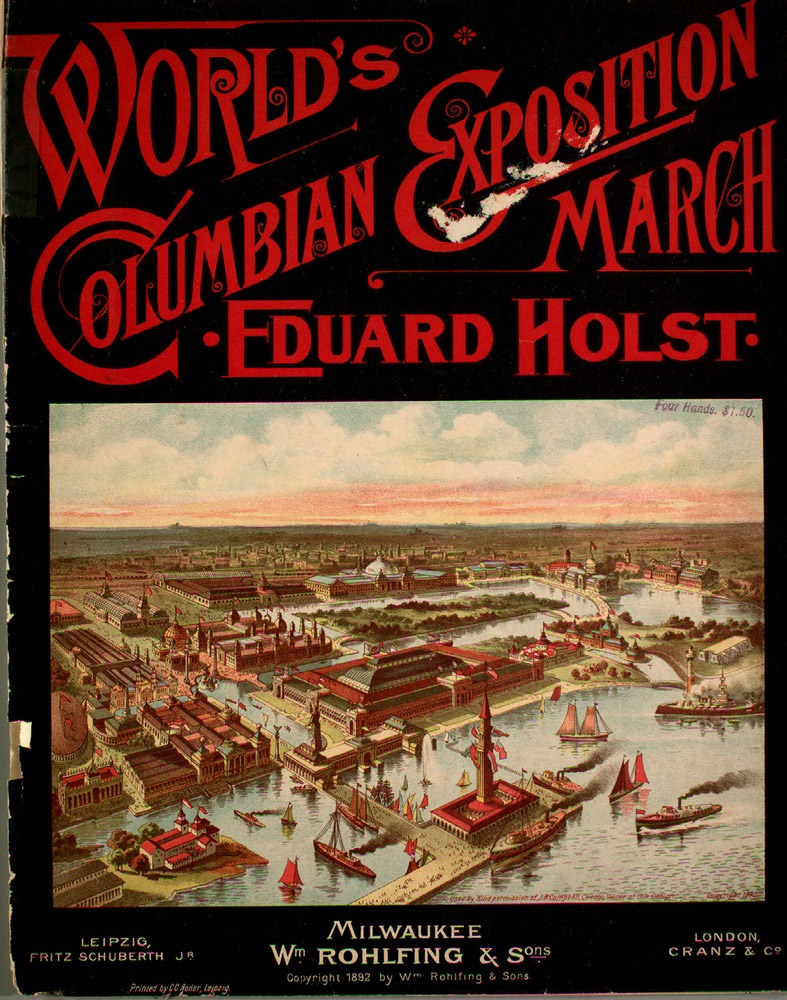
World's Columbian Exposition
March by Eduard Holst, Wm. Rohlfing & Sons, Milwaukee, 1892 (Source:
Lester
S. Levy Sheet Music Collection, Johns Hopkins.)
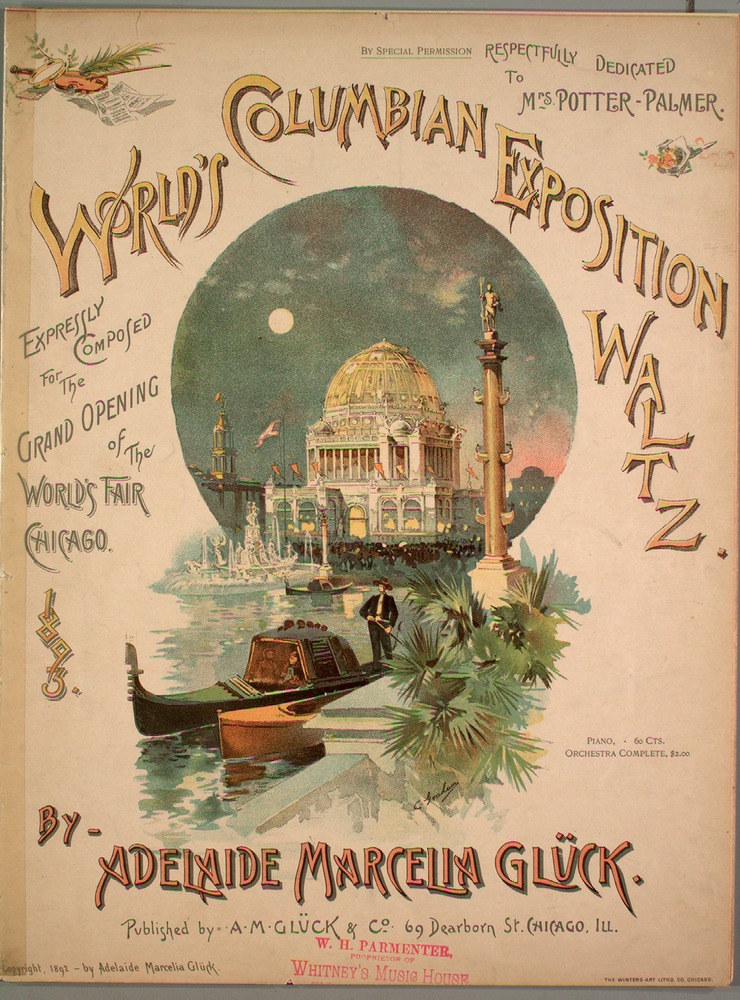
"World's Columbian
Exposition Waltz," by Adelaide Marcelia Gluck. Publisher A.M.
Gluck & Co., Chicago, 1892 - Composed for the opening of the fair
and "Respectfully Dedicated to Mrs. Potter-Palmer." (Source:
Lester
S. Levy Sheet Music Collection, Johns Hopkins).
Edison's Phonograph
Exhibit in the Electricity Building - Social and Commercial Uses
of the Phonograph
In the Official Guide to the World's
Columbian Exposition the following was written about Edison's
Phonograph Exhibit in The Electricity Building.
The commercial and social uses
of the phonograph, it was said, included conversations of
all types with the options of those words being delivered
in your own voice or transcribed into a letter and sent.
Conversations between husband
and wife across the globe were possible because of the phonograph;
intimate words could be said and heard even for long distance
relationships; and the business man can dictate letters at
any hour.

Official Guide to the World's
Columbian Exposition describing some uses of the Phonograph,
p. 71
Descriptions of the Electricity
Building and of Edison's Phonograph exhibits were included in
The Phonogram's March-April 1893 issue that summarized by
stating "among all the exhibits in the World's Fair, none will
be more calculated to stimulate the pride of the true American than
these silent witnesses to the achievements of his countrymen--THOMAS
A. EDISON."
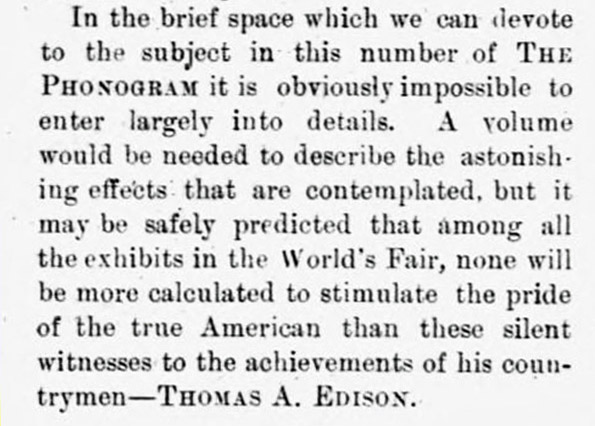
The space that belonged to the North
American Phonograph Company in the Electricity Building was divided
into four areas. One was for company business related to the World's
Fair. Another for the exhibition of the domestic phonograph and
to illustrate the social application of the instrument. The third
was to exhibit the commercial phonograph with examples of its advantages
for business. And the fourth devoted to the educational purposes
of the phonograph.
Another area was to be glass enclosed
with a piano and special exhibits to demonstrate "the infinite
uses to which this wonderful instrument may be applied." Phonographs
would be operated from electric light circuits and from primary
and secondary batteries. Among some of the recordings promised were
"music from many of the great artists of the world, from famous
orchestras and other organizations of whose performances in the
flesh we only know by reading cold type. Here, we may close our
eyes and imagine ourselves in the very atmosphere of genius."
Voices of Edison and William
Gladstone could also be heard and hundreds of others.
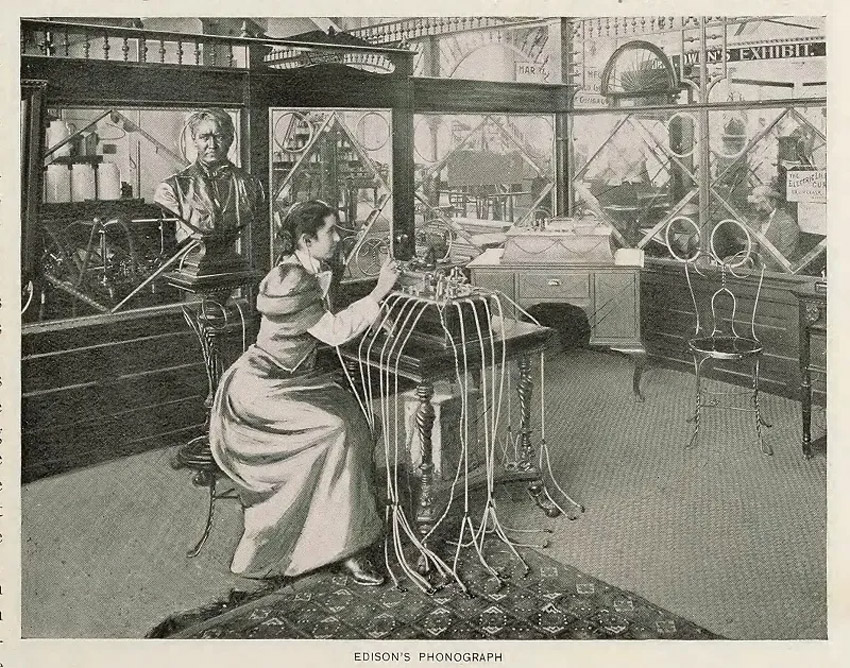
Edison’s special phonograph exhibit
described by The Phonogram was glass enclosed and one of
the spaces designed by the North American Phonograph Company in
the Electricity Building. (Image
from Bancroft, Hubert Howe's The Book of the Fair. The Bancroft
Company, 1893.) (1A)
In the back corner of
Edison's glass enclosed phonograph exhibit was the 1893 "newly
designed cabinet."
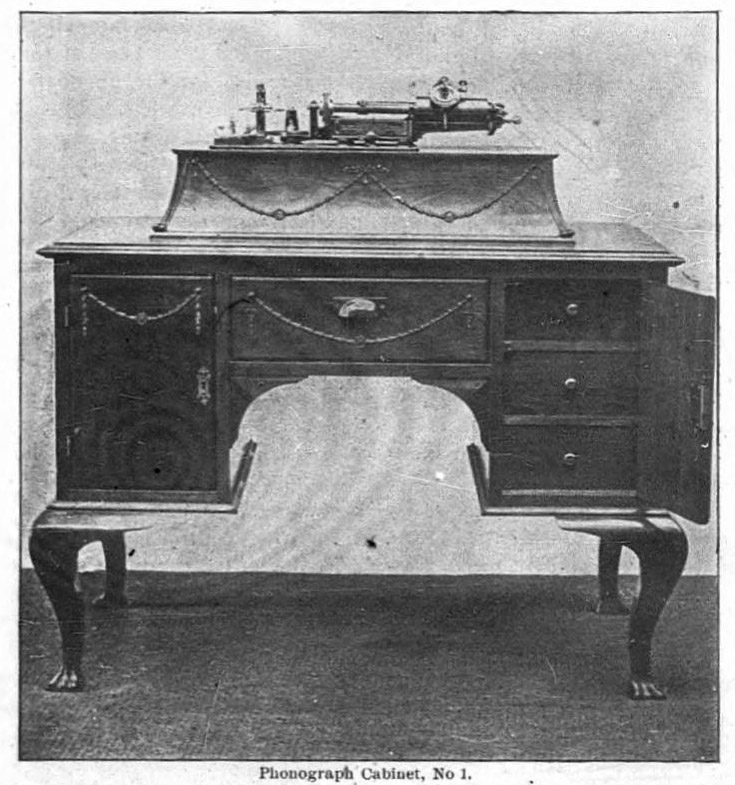
"The North American Phonograph
Co. will make a large display of these cabinets in different woods
at the Columbian Exposition." The
Phonogram, March and April 1893 p. 388.
Phonograph Music in the Model Electrical
House
The model house which was designed
"to demonstrate every economic application of electricity to
domestic purposes" included a loud-toned electric phonograph
which could entertain guests by playing selections from "Faust,"
by Strauss' orchestra, "or snatches of a sacred melody by Gilmore's
Ocean Grove orchestra."
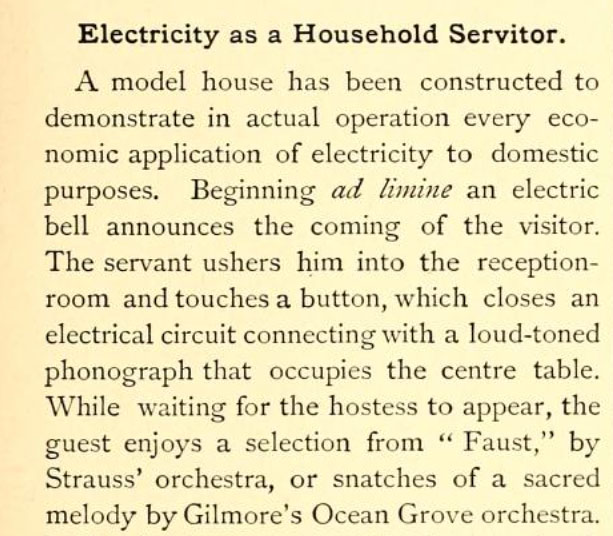
The World's Fair, Being a Pictorial
History of The Columbian Exposition, P. D. Farrell & Co.,
1893, p.327
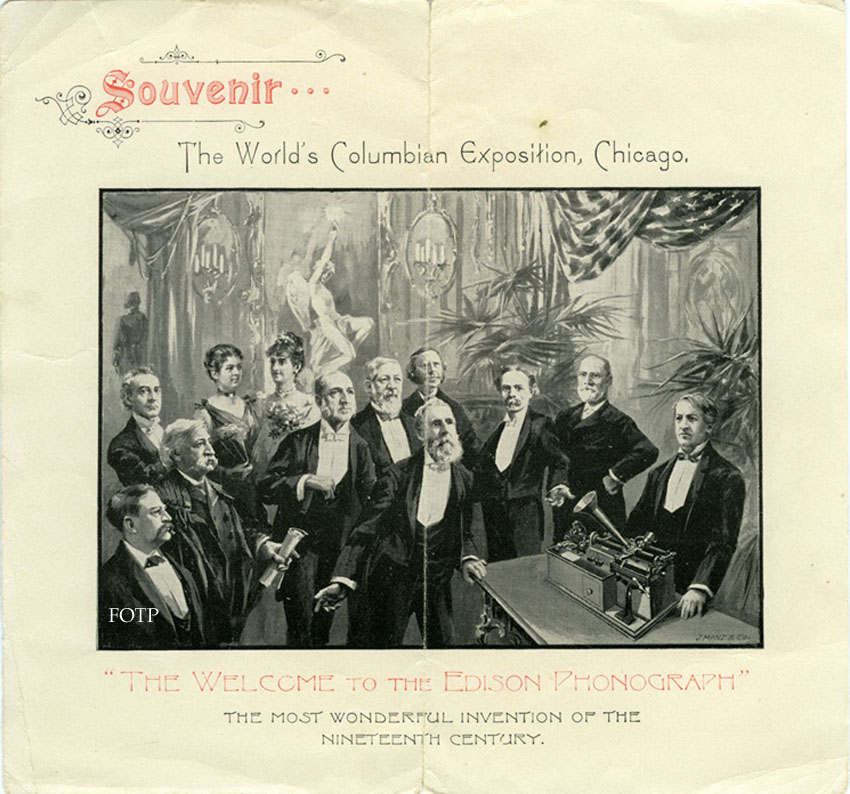
Souvenir from the Phonographia
Collection (PM-0112)
This souvenir from the
1893 Columbia Exposition shows Edison demonstrating his Edison Class
M Phonograph which was electric (battery) powered. Promoted here
as "the most wonderful invention of the nineteenth century." It
is not clear, however, when Edison was actually at the fair with
dates of August 18, 1893 as potentially the earliest (while the
fair was open) and the Pensecola
News in their August 23 edition reporting an interview with
him at the fair grounds on August 21, 1893.
Promoting the Phonograph - Demonstrations,
Lectures and Soirre
Demonstrations, lectures and other
activities to promote the phonograph were sponsored in the Electricity
Building by the North American Phonograph Company. Presentations
like these had been used since the earliest days of promoting Edison's
tinfoil phonograph but a world's fair with a record-setting attendance
offered the opportunity for the phonograph to be seen and heard
by thousands of visitors in one venue.
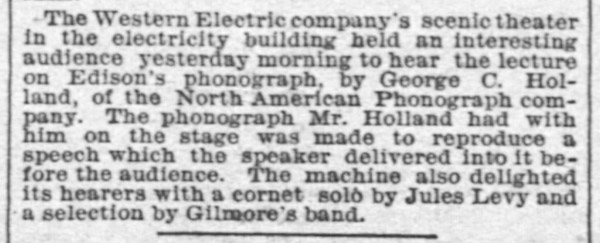
The Daily Inter
Ocean, Chicago, August 16, 1893 p. 7
In 1893 the North American
Phonograph Co. was selling Edison Phonographs for business use,
exhibitions, as nickel-in-the-slots, and for home entertainment.
Musical and other recordings and blank cylinders to make your own
recordings were also for sale.

The
Phonogram, March and April, 1893 "The
World's Fair Number"
Advertising these four
phonograph "outfits" in 1893 reflected the existence of
the multiple phonograph markets before the home market would emerge
and dominate.
By 1897 the home market
was growing and phonograph advertising was seen in more and more
consumer magazines. The following Columbia Graphophone ad is an
example of how those four markets were still important in 1897 and
how they appeared in consumer magazines like The Cosmopolitan
(as opposed to the 1893 ads when much of the promotion of the phonograph
was being done in the talking machine industry's trade magazines
like The Phonogram.
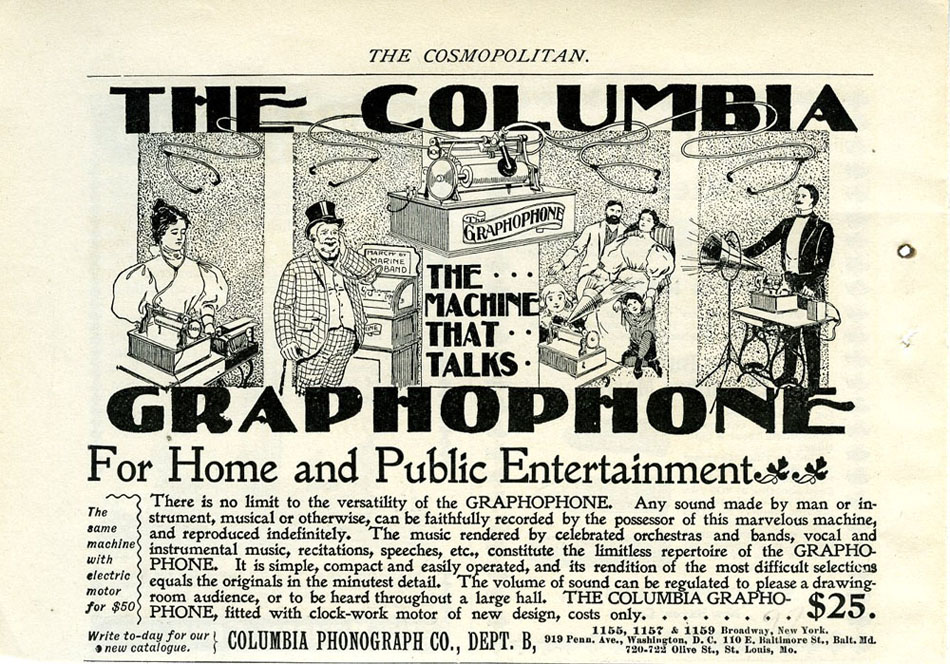
Business, Nickel-in-the-slot, Home and
Exhibition - The Columbia Graphophone, The Cosmopolitan, 1897
(PM-0920)
For more examples of
pre-1900 Phonograph ads, visit Phonographia's PhonoAds
"THE
ELECTRIC HOUSE" in the Electricity Building
The
World's Columbian Exposition's "THE ELECTRIC HOUSE"
was called
by The Examiner, San Francisco, April 24, 1891 "one
of the wonders to be exhibited at the world's fair" that
would display the many uses of electricity for the home.
The kitchen
was to have electrical appliances like an electric range,
electric dishwasher; the washing, ironing and scrubbing of the
floors and woodwork would all be electrically performed and
even the washing of the windows would be done by electricity.
For examples of that future
see some of the later Edison/Hotpoint kitchens and kitchen appliance
ads including the World War
II Hotpoint ads (Edison General Electric Appliance Co.)
asking families to buy War Bonds to help win the war so that
"Someday we'll have an electric kitchen" when Hotpoint
can make appliances instead of war materials.)
A phonograph, powered
by electricity, was planned for the parlor and for the home's
office in the Electric House (the Edison Class "M"
Phonograph was battery powered and the Class "E" used
D.C. lighting circuit).
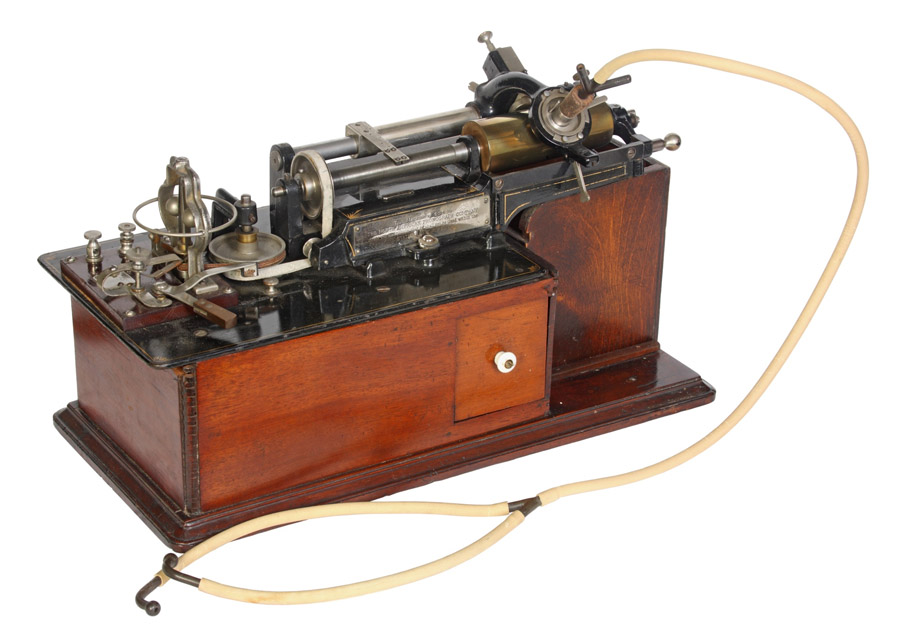
Edison Class M Phonograph
(Courtesy The
British Library)
This Edison Class
M was sold by The North American Phonograph Co. primarily for
commercial use but would also have been in
a few homes, circa 1893. (2)
The New Phonograph
for the Home
"In the social
exhibit the new household machine is shown for the first time...This
is the realization of Mr. Edison's ideal...that the best music,
vocal and instrumental, oratory, elocutions, readings and sermons
could be brought into the home..."
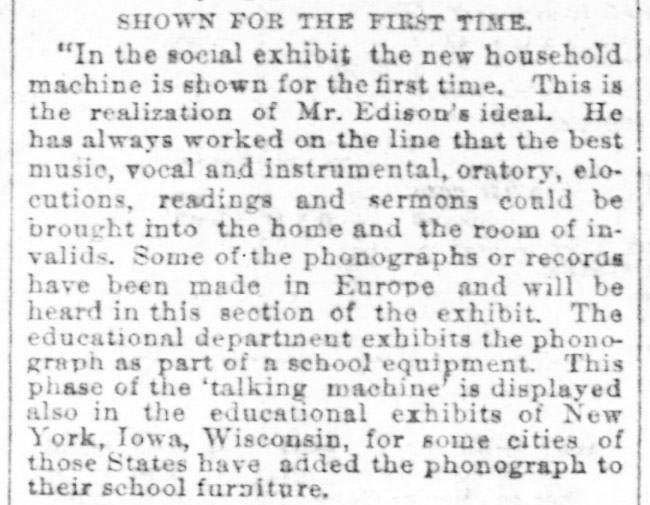
The Indianapolis News,
Indiana April 27, 1893 p. 5
Facsimile Figures at the Fair
and the Phonograph
The last paragraph of The Examiner's
April 24, 1891 article about the Electric House describes
the proposed Adelina Patti automaton which would have been a true
wonder to "the genius of man" if it had been built.
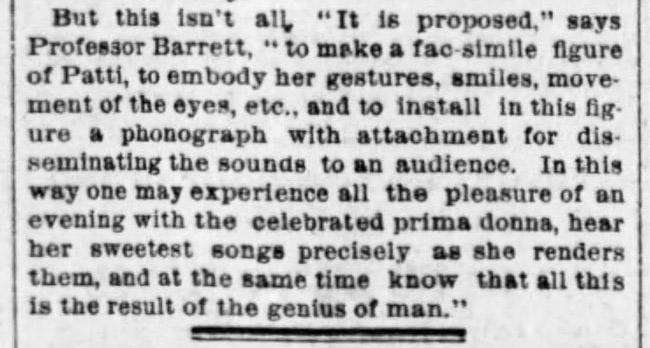
The Examiner,
San Francisco, April 24, 1891
The facsimile figure of Patti with
a phonograph installed inside her was never built. Patti did make
a recording circa 1890 but it has been lost and its title is unknown.(2).
Uncle Sam, the Edison Phonograph
and Hub Gore
No facsimile of Patti singing her
"sweetest songs" but "Uncle Sam, the Wonderful
Edison Talking Automaton," was at the fair delivering his
speeches. The Hub Gore trade card (see below) said that Uncle
Sam delivered 40,000 speeches using the Edison phonograph during
the 1893 World's Columbian Exposition. Published sometime after
the fair was over the trade card showed Uncle Sam in an open area
where crowds of visitors gathered around and attentively listened.
Research in 2023 by Allen Koenigsberg,
however, found that Hub Gore's Uncle Sam figure wasn't on the
Fair's Midway Plaisance or anywhere outside. Instead, "Uncle
Sam, the Wonderful Edison Talking Automaton" was located
in the Fair's Shoe and Leather Building. Although
still not confirmed that it was actually an automaton Koenigsberg
did locate a previously unknown photograph of the effigy of Uncle
Sam standing above the height of visitors in the Hub Gore gallery
with text mounted below Uncle Sam for visitors to read as he gave
his speech via the phonograph.
For more details about this remarkable
connection between the phonograph and the World's Fair of 1893
see the Antique Phonograph's “Rest
about 10 seconds between speeches.” The Uncle Sam Mystery
at the 1893 World’s Fair by Allen Koenigsberg, March 2023.
For other examples of Uncle Sam's
presence at the 1893 Chicago World's Fair see Uncle
Sam and the World's Columbian Exposition of 1893.
Trade card showing Uncle Sam promoting
Hub Gore's Congress Shoes at the 1893 Columbian Exposition with
the automaton using an Edison Phonograph to "talk." (Beacon
Lith Co. Boston, 1894) (PM-0650)
UNCLE SAM'S SPEECH.
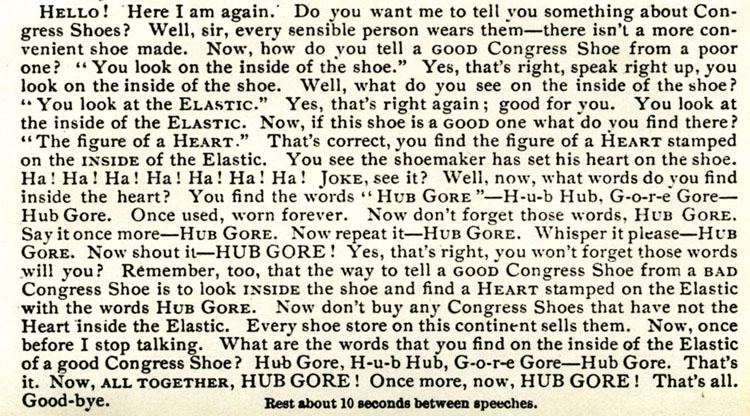
Courtesy of The Warshaw
Collection of Business Americana, Archives, Smithsonian Institution
The Bernese Alps Cyclorama and
the Phonograph
The Bernese
Alps Cyclorama on the Midway Plaisance used a phonograph as
part of its cycloramic form "to make the deception complete, as
one's ears are greeted with the strains of a Swiss ballad seeming
to proceed from the maid."
The Electricity Building - Nickel-in-the-Slots
In the Electricity Building there
was no charge to listen to Edison's Phonograph in the "space
allotted to the North American Co., but many coin-in-the slot machines
are likely to be scattered through the premises."(3)
.
"The great Electricity building
is filled with curious exhibits of an electrical character.
To the left as you enter from the north front a large circular
space is devoted to phonographs, where one at the expense of
a few coppers may amuse himself for an hour."
On the Midway Plaisance - Nickel-in-the-Slots
Nickel-in-the-slot phonographs and
graphophones were available on the World's Fair's Midway
Plaisance.
In the book Six Months at the
World's Fair by Mrs. Mark Stevens published in 1895 her impressions
of the fair are covered as much as possible or the author subtitled
her book "A little here and a little there of the Great White
City --The World's Fair." One scene regarding the phonograph
is in the chapter "An Evening on Midway" with a party
of gentlemen stopping to listen to the phonograph under the aqueduct
play "I Have Worked Ten Hours this Day."
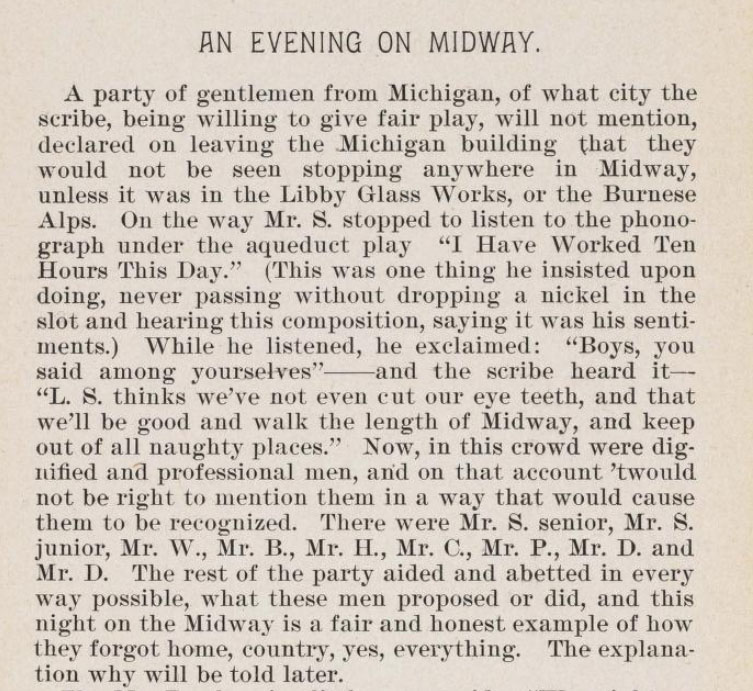
Six Months at
the World's Fair by Mrs. Mark Stevens, The Detroit Free Press
Printing Company, ©1895, p. 117.
History of Phonograph Parlors
and Nickel-in-the-Slot Phonographs
The first nickel-in-the-slot Phonograph
had been installed on November 23, 1889 in the Palais Royal Saloon,
Sutter Street, San Francisco. Coin-operated phonographs would
soon be placed in hotels, railroad and ferry stations, saloons
and other public places in addition to formal Phonograph Parlors
in larger cities where multiple machines could be heard.
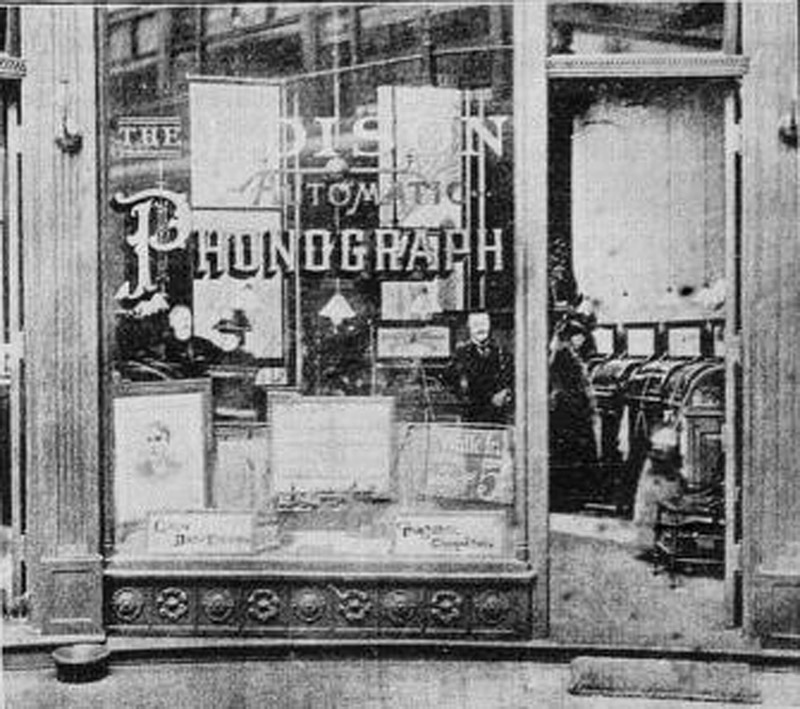
Phonograph Parlor in
Ohio, November 1891
For details about the
Exhibition Parlors in Cleveland and Cincinnati operated by the Ohio
Phonograph Company in 1891 see Exhibition
Parlors of the Ohio Company, The Phonogram, November-December,
1891.
The above Edison nickel-in-the-slot
phonographs were exhibited at the American Institute Fair in New
York City in October 1892. Fifteen machines were available for play
plus "an exhibition machine, connected with which is an eighteen-way
hearing tube, that affords visitors the opportunity of listening,
eighteen at once, to the music." The Phonogram, October
1892
By the time people visited the World's
Columbian Exposition in 1893 there would have been opportunities
for some to have already seen or heard the phonograph because of
these coin-in-the-slot machines or even one of the early commercial
phonographs being sold as social and business machines. Or if you
were the Sultan of Morocco you would have also had the opportunity
to hear a phonograph as the Sultan did a year before the fair opened
when he was discussing with World's Fair agents Morocco's participation
in the upcoming World's Fair. The Sultan was reportedly quite impressed
with the phonograph.
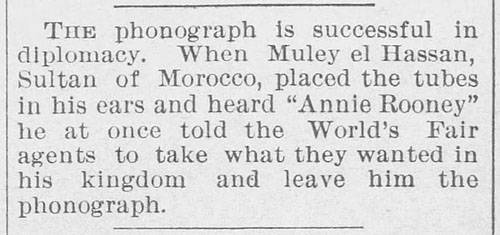
The Rushville Standard,
Sheridan, NE, May 20, 1892
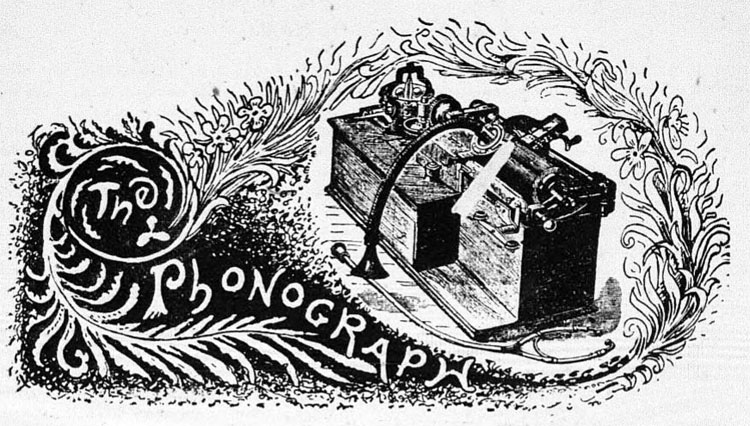
The Phonograph with listening
tubes promoted for social and business purposes, The North American
Phonograph Co., The Phonogram, March 1892
The
Phonograph and Educational Uses
Prior to the Exposition opening
on May 1, 1893 there were a number of phonograph related articles
about some of the exhibitions that could soon be seen the World's
Fair. The Phonograph's impact on education was one of those themes
being encouraged by the phonograph industry.
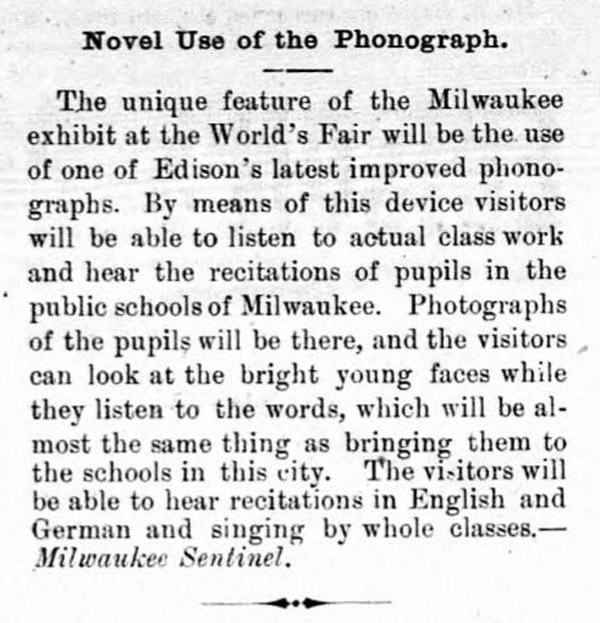
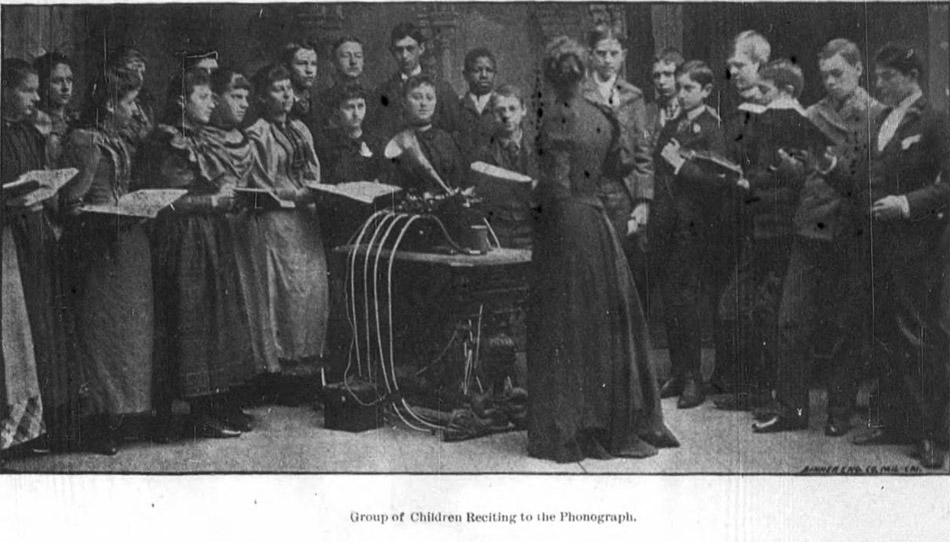
The
Phonogram, March-April 1893, p. 361
"The taking of a record
before a class of Milwaukee children, under the direction of a
teacher. A large receiving funnel or a number of receiving tubes
is placed upon the machine and the sounds of the voices in the
school room are transmitted upon wax cylinders. These are called
“ records ” and show only slight indentations upon their surface."
The Phonogram, March-April 1893, p. 362-363
Four phonographs
to be used for exhibiting Omaha public school's music at the World's
Fair
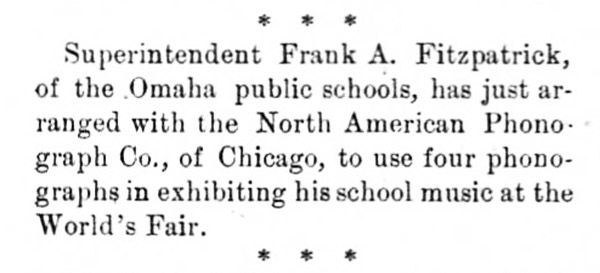
The
Phonogram, March and April 1893, p.
399
Newspapers had articles throughout
the six-month fair regarding Edison's phonograph emphasizing
that there were hundreds of educational and business uses
for the phonograph and that Edison's Phonograph Exhibit was
devoted to illustrating those uses.
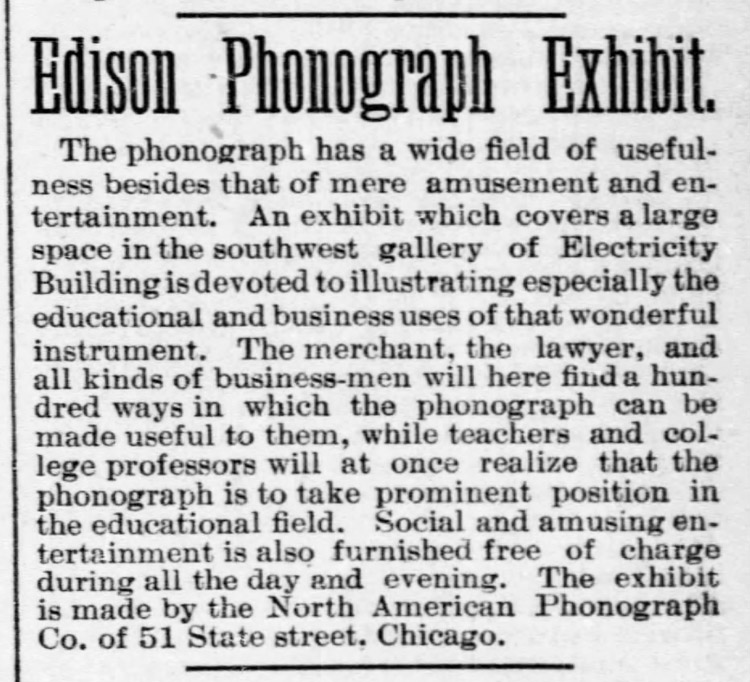
Electricity Building Exhibit,
Chicago Tribune, September 2, 1893
For more examples of
phonograph and Edison's education exhibits at the fair see The
World's Columbian Exposition, the Phonograph and Education.
The Phonograph
and Business Uses
The phonograph as a
business machine used for dictation and letter writing had been
at the top of Edison's list since 1878. Under the newly chartered
North American Phonograph Company Jesse H. Lippincott in 1888
had licensed the patents for Edison's Phonograph and for Bell-Tainter's
Graphophones. Each company would make and sell their respective
phonographs and graphophones to the North American Phonograph
Company which in turn would lease them to regional sub-companies,
who would then rent the machines to local businesses for dictation.(1)
For many reasons Lippincott's
company struggled and would fail, and many legal battles wouldn't
be resolved until the end of 1896. In the meantime, Edison was
actively promoting its use as a business machine.
Within that context
Edison in 1893 was President of the North American Phonograph
Company and the phonograph was being promoted as a business machine
and as one of the phonograph's main themes at the World's Fair.
"In a few years
no live business man will think of dictating correspondence to
a stenographer" wrote The Phonogram in April 1893.
The Phonograph is "The Ideal Stenographer."
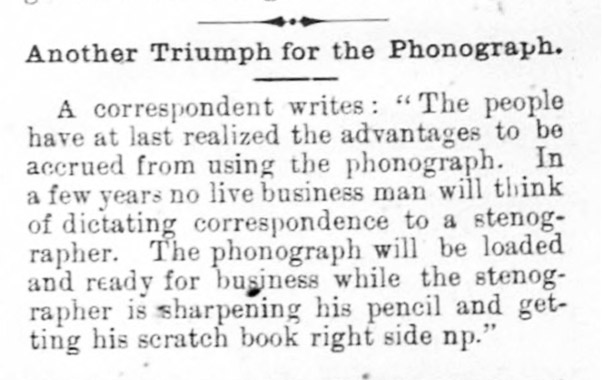
The
Phonogram, March and April 1893 pp.
367
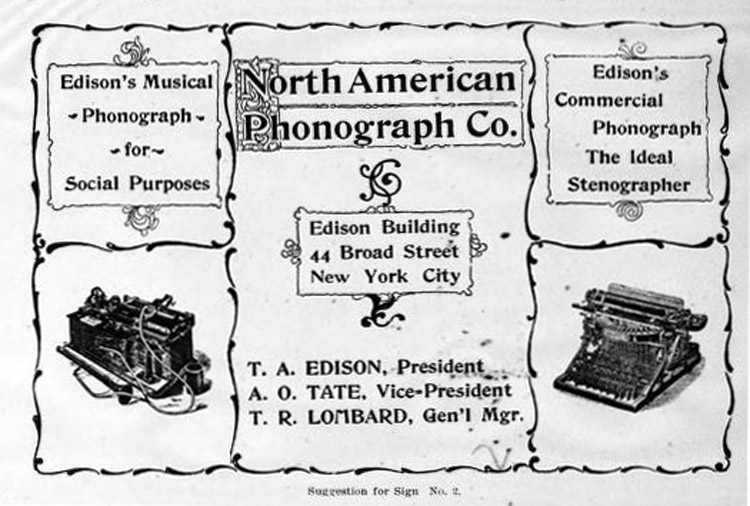
Social and Commercial
Purposes - Musical and The Ideal Stenographer
The Phonogram,
November 1892
In an ad repeated
in The Phonogram every month in 1893 leading up to the
fair Edison advertised "10 Reasons Why the Phonograph is
Superior to Any Stenographer."
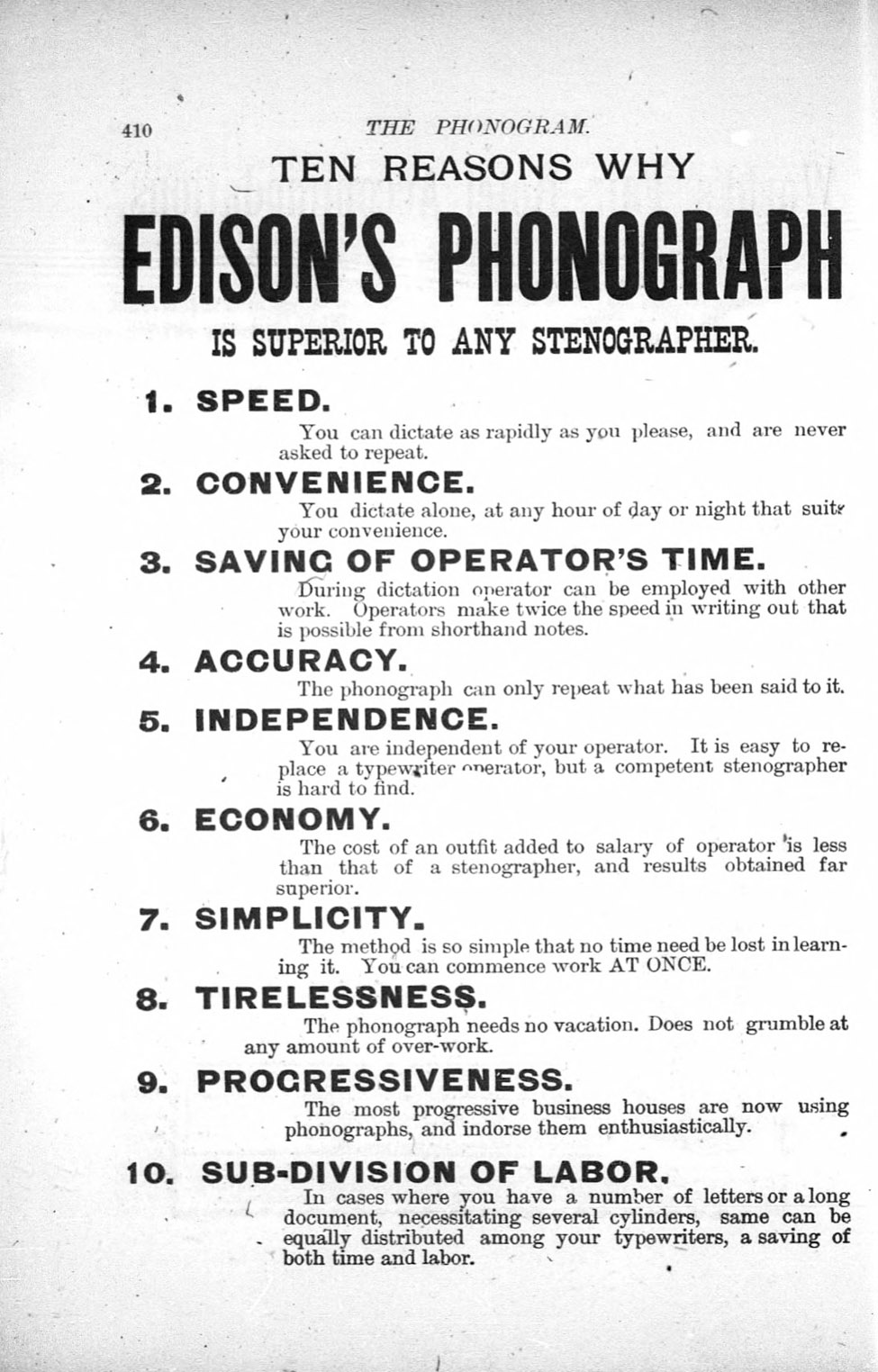
The Phonogram,
March-April 1893
The Edison Phonograph
"The Ideal Amanuensis" Circular Letter, September 18,
1893
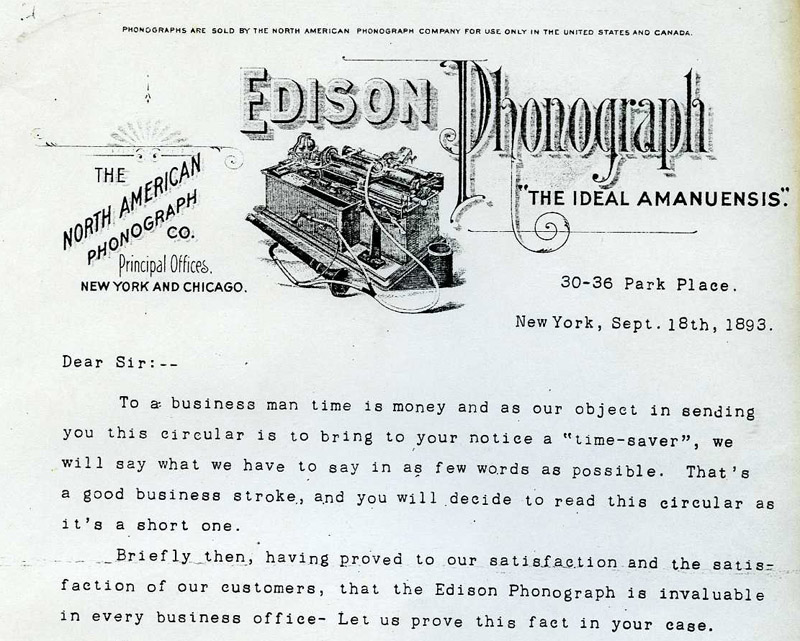
READ
HERE for the rest of this circular sent to prospective businesses
(Courtesy Thomas Edison National Historic Park)
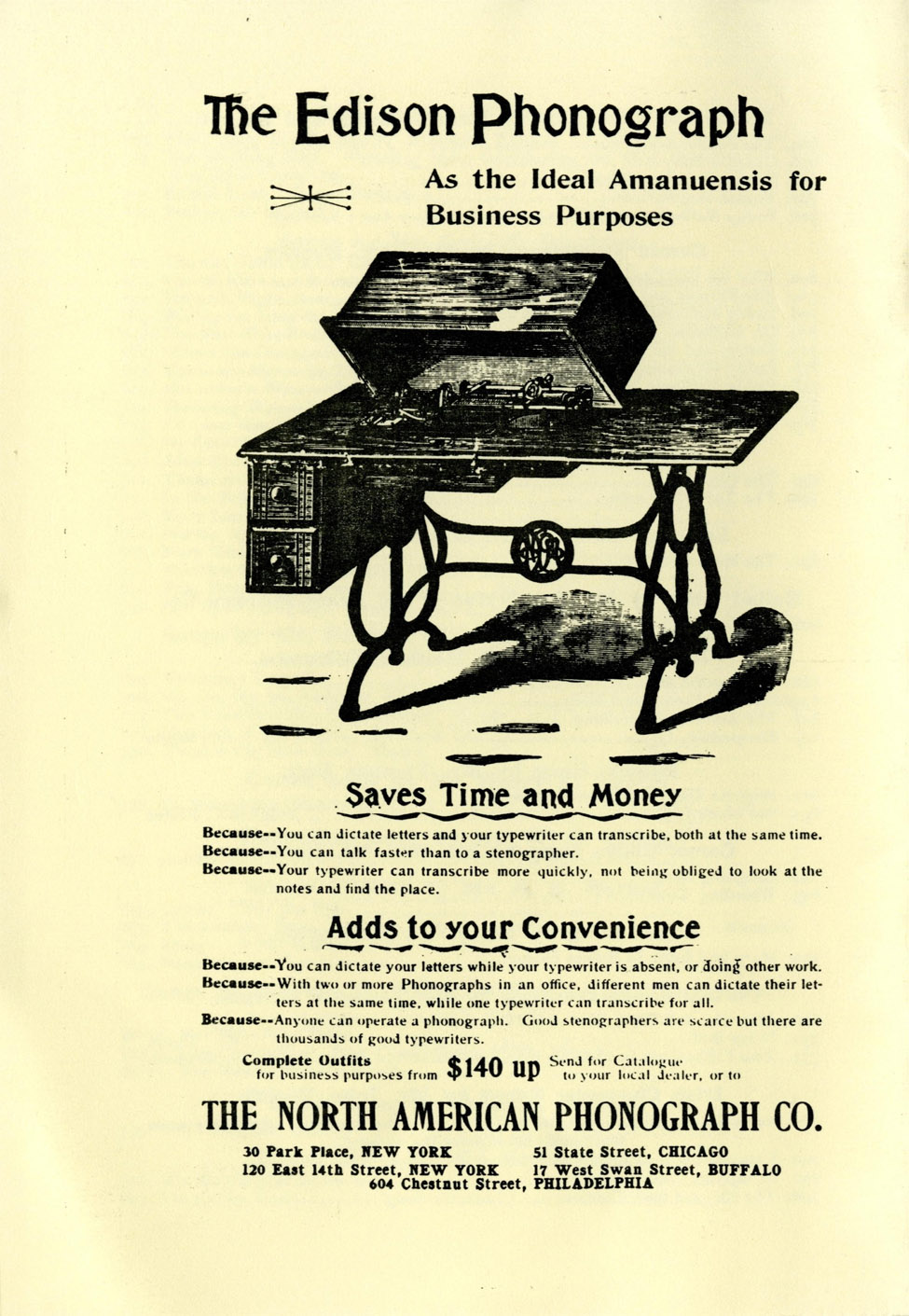
The North
American Phonograph Company Catalogue,
November 1893
Pope Leo XIII Sends
Greetings to American People by means of Edison's Phonograph
Pope Leo XIII used an Edison Phonograph
to send a message to the American people which he hoped would be
heard at the opening of the World's Columbian Exposition. Although
it wasn't heard by the public on opening day the illustration of
the Pope speaking into a phonograph was essentially an endorsement
for the phonograph industry. If the Pope was using it for composing
and sending a message then why shouldn't the business world do the
same?
The London Telegraph or The
Graphic, April 15, 1893 (PM-0563)
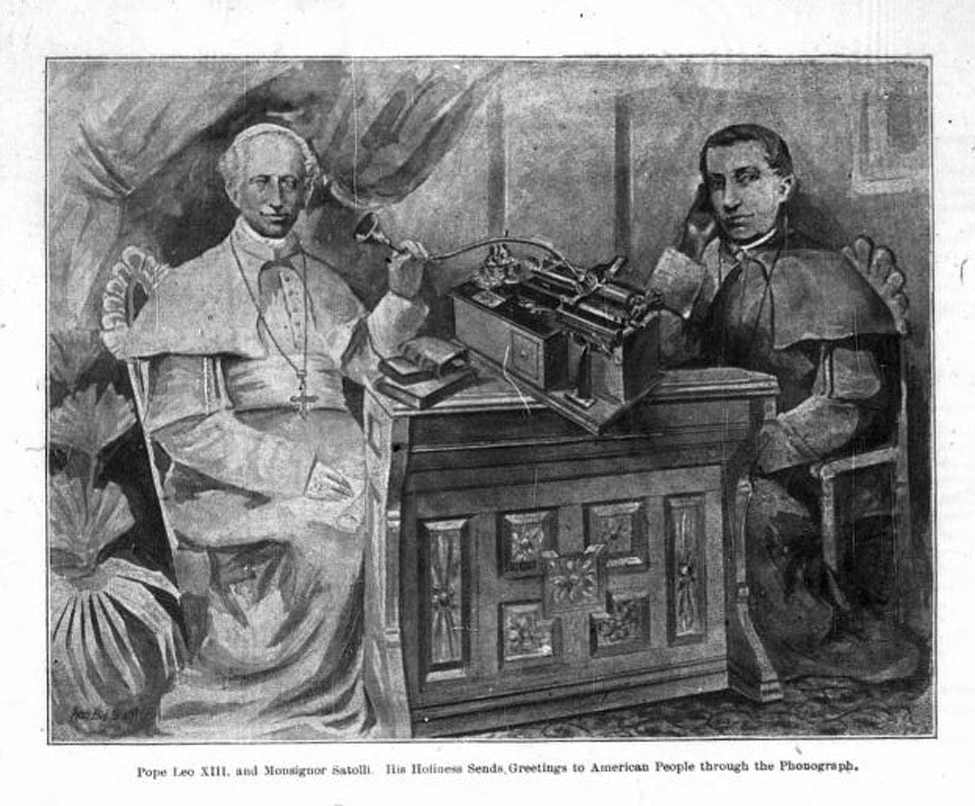
Pope
Leo XIII sends greetings for the opening of the World's Columbian
Exposition.
The Phonogram,
March and April 1893
The greetings from Pope
Leo XIII using Edison's Phonograph was said to be for the opening
of the World's Columbian Exposition and The
Phonogram noted that Pope's phonograph recorded words would
be the first time in the history of the Church that the voice of
the Sovereign Pontiff would be heard in America. (Read
Belfer Collection article here)
The 1893 cylinder recording
that was to have been on display at the fair is now lost. The Belfer
Collection, however, has a recording
of Pope Leo XIII made on February 5, 1903 in the Vatican
made by inventor and entrepreneur Gianni Bettini. On that recording,
Pope Leo recites the “Ave Maria” (Hail Mary) in Latin, as well as
a Benediction...Bettini of Paris, would lease the rights to Columbia
for release in the U.S. (Belfer, Ibid.)
"Fair Fiction"
PhonoLiterature
Some interesting descriptions of visitor's
seeing and hearing the phonograph at the fair were recorded in popular
culture in a genre of literature which has been called "fair
fiction." "Fair
fiction" uses the setting of a 'fair' in its story. One
of those authors, Marietta Holley (author of Samantha at the
World's Fair, Samantha at the St. Louis Exposition, Samantha
in Europe, and Around the World with Josiah Allen's Wife)
wrote all of her books about visiting fairs and other destinations
without ever actually going to any of those places.
The following are four examples of
'fair fiction' books which were written about the World's Columbian
Exposition. Scenes involving Edison's phonograph, the Electricity
Building, and coin-in-the-slot listening experiences are included
here and in Phonographia's Library of phonograph connected books,
PhonoLiterature.
The
City of Wonders
Nora, one of the Barrett
children visiting the Columbian Exposition in The City of Wonders,
said the Edison Tower in the Electricity building “is like
a pillar built with millions of jewels.”
But it was the phonograph
in the Edison exhibit of the Electricity building where the Barrett
family was astounded by what they saw and heard. “Now,” said
Uncle Jack, “you shall hear the marvellous echo-voice of the phonograph,–a
voice capable of preserving and repeating the words and accents
of those dear to us, months and years after they have been uttered,–when
perhaps the lips that spoke them are mute forever.”
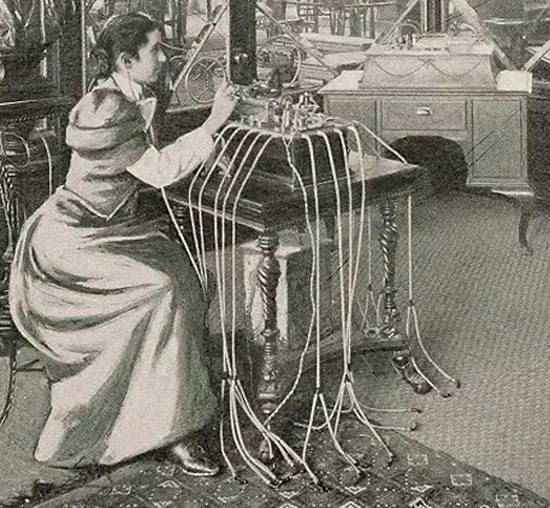
Thomas Edison’s phonograph
exhibit in the Electricity Building.
(Image from Bancroft,
Hubert Howe's The Book of the Fair. The Bancroft Company,
1893.) (1)
Uncle Jack and each of the Barrett
children listened through the listening tubes to one of Longfellow's
poems, "a song by a popular professional singer," then
a "piece by a brilliant performance of instrumental music.
“It is hard to believe that some
one is not playing the piano right near here.” exclaimed Aleck.
President Cleveland‘s voice,
and the words are those of his inaugural address, and finally
a German lesson from the phonograph.
Uncle Jack also pointed out to
the children that the phonograph was a 'clever little messenger"
so that a traveler instead of writing to his friends at home,
can box up a cylinder full of tourist’s gossip, and send it by
express.
Samantha
at the World's Fair
Chapter XVIII's "The
Electricity Building" describes the wonders of electricity
in 1893 featuring the Electric House "all fitted up from
basement to attic with electricity." A phonograph in
its parlor offers selections from "operatic or sacred
music or comic songs....Or if they want to hear Gladstone debate,
or Chauncey Depew joke, or Ingersoll lecture, or no matter what
their tastes are, they can be gratified. The phonograph don't
care; it will bring to 'em anything they call for."
The
Adventures of Uncle Jeremiah and Family at the Great Fair
The following is a
visit by Uncle Jeremiah and his family to the Manufacturers and
Liberal Arts building and the first thing they see are coin-operated
Columbia graphophones and Edison phonographs. Both machines were
popular with the public during the six months the fair was open
and likewise were quite profitable. Here is the excerpt:
As they entered
the Manufacturers and Liberal Arts building through one of the small
entrances on the north, the greatness of that more than forty-four
acres of exhibits did not impress itself upon them. The first objects
that met their gaze were the graphophones or phonographs. Some nickles
were soon in the slots and the family for the first time listening
to music coming from some where by singers unseen. Johnny had a
face covered with smiles as he listened to some loud-mouthed artist
singing "Throw him down McClosky." Between each verse Johnny told
the boy who stood in open-mouthed wonder near him that the "feller
is a singer from way back." He could not realize that he was not
in a concert hall and that all standing about were not hearing what
he heard. When the music ceased and he withdrew the tubes from his
ears he said to the boy, "Wasn't that out of sight?"
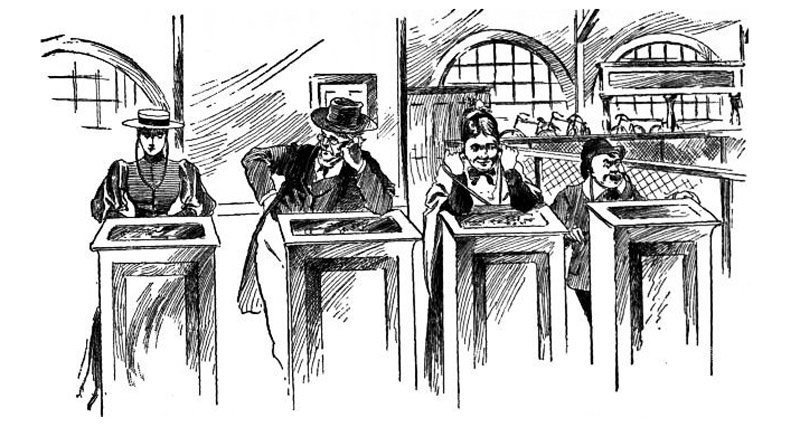
"They listened to
melodies by musicians unseen, and from somewhere unknown."
The
Century World's Fair Book for Boys and Girls
Harry and Philip are
the two boys visiting the fair with their tutor. In the following
scene the boys are without their tutor and are visiting the Manufacturers
and Liberal Arts Building.
Since Harry had
refused to go further into the exhibits of school work, they went
down to the main floor, and walked from the southwest corner northward.
As in the other buildings they had visited, they found along the
walls little stands where young women had on sale penholders,
souvenir coins, shell-boxes, necklaces—cheap trinkets of all sorts.
For the first few days the boys had gone to see what was shown
at these booths; but soon they found there was pretty much the
same stock everywhere, and walked by indifferently. They had bought,
however, a few things—one a little shield showing the arms Queen
Isabella granted to Columbus.
Against the wall about half-way up
toward the north end were several “graphophones”—contrivances
something like Edison’s phonograph. On dropping a nickel and
hooking two hard-rubber tubes into the ears, one might hear instrumental
music or songs. A small boy tried one of those machines while Harry
and Philip looked on. The tubes were adjusted, and he stood gravely
awaiting the result. A smile began to dawn on his lips. It spread
widely. His mouth opened; he giggled aloud; he kept on giggling with
his eyes closing through pure joy.
Harry tried the machine
and found that it was repeating a comic singer’s rendering of “The
Cat Came Back,” and he grinned quite as widely as the small boy had
done, and afterward sketched the scene with full sympathy."
“—AND THE CAT CAME
BACK.”
“That’s a great
invention for invalids,” said Philip, thoughtfully.
“Yes,” said Harry,
warmly; “think how it would soothe a restless invalid during a
long night to hear one of those machines grind out ‘The Cat Came
Back!’”
“Well, it would,”
said Philip, as soberly as he could. “You couldn’t be sad while
listening to that song.”
Just as they were
leaving, they saw a mother and child listening to the same graphophone,
each having one ear to an end of the branched tube. “I don’t know,”
said Philip, “whether that’s quite honest.”
The Kinetograph
The kinetograph in 1891 was defined
as a "Motion writing" instrument, a camera that could
take moving photographs. It was called "a Companion to the
Phonograph," a "Brother to the Phonograph," and was
said that it would be "more wonderful than the phonograph."
Edison's new kinetograph was
to "transmit scenes to the eye as well as sounds to the ear."
The "movements of the lips" of a prima donna,
it was said, would be seen as her words of the song were
produced by the phonograph.
In July 1891 the Chicago Tribune
reported that "Edison's new kinetograph would be complete in
all its details by the time of the opening of the world's fair,
at which it is to be exhibited."
There
is no evidence that the kinetoscope was ever exhibited at
the Chicago fair. There remains the possibility that there
was a kinetograph exhibit in the Electricity Building but
there is no evidence that it was operational or had any device
on display.
For the story of the kinetograph
and kinetoscope at the Chicago World's Fair see The
World's Columbian Exposition of 1893 and the "Kinetograph"
The World's Columbian Exposition
Closes
The Exposition closed on October 30,
1893. The phonograph had been seen and heard by countless fair visitors.
It had received good publicity in the popular press (with much of
it probably inserted by the phonograph industry itself). Edison's
nickel-in-the-slot phonographs had been profitable. And the phonograph
as a social and commercial machine would be visualized by many for
its future in the home, in education and in business.
For Edison the World's Columbian Exposition
of 1893 was not Paris of 1889. Edison had lost the fair's lighting
system contract to Westinghouse and Edison was not able to deliver
his kinetoscopes to the fair.
The following newspaper article, however,
highlighted Edison's success at the fair and reads like Edison helped
write it with the headline "EDISON PHONOGRAPH AWARDS"
followed by its congratulations to Mr. Lombard, the general manager
of the Edison phonograph, and to the Edison company upon the
"success of his exhibit at The Fair."
How did the success of the Columbian
Exposition also provide success at the fair for Edison?
It was the phonograph.
The phonograph had participated in
the World's Columbian Exposition which was said to have provided
an impetus "to the onward progress of science." And then
the superlative: "Among the achieved phenomenal results of
modern science none occupy a more conspicuous place in the practical
world than the Edison phonograph."
If it was actually true that "Among
the achieved phenomenal results of modern science" nothing
is more clearly visible "in the practical world"
than Edison's phonograph then that recognition was a very big
success for Edison.
True or not, I doubt Edison would
have changed a word.
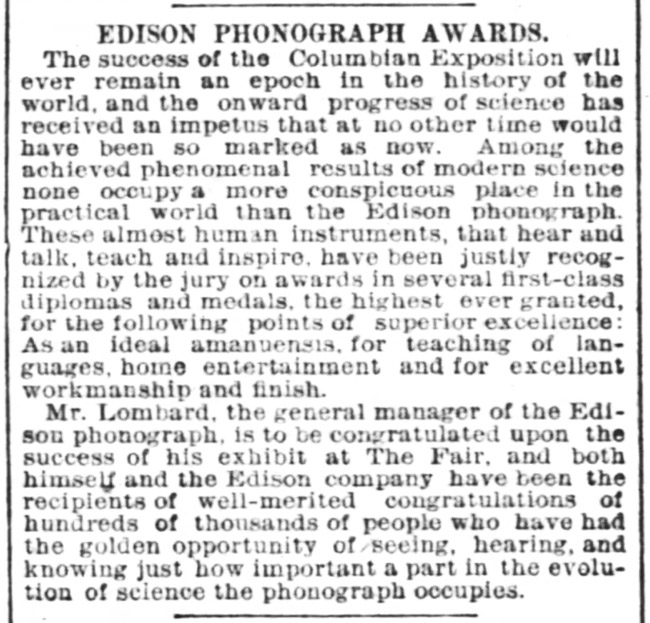
The Daily Inter Ocean,
Chicago, November 1, 1893
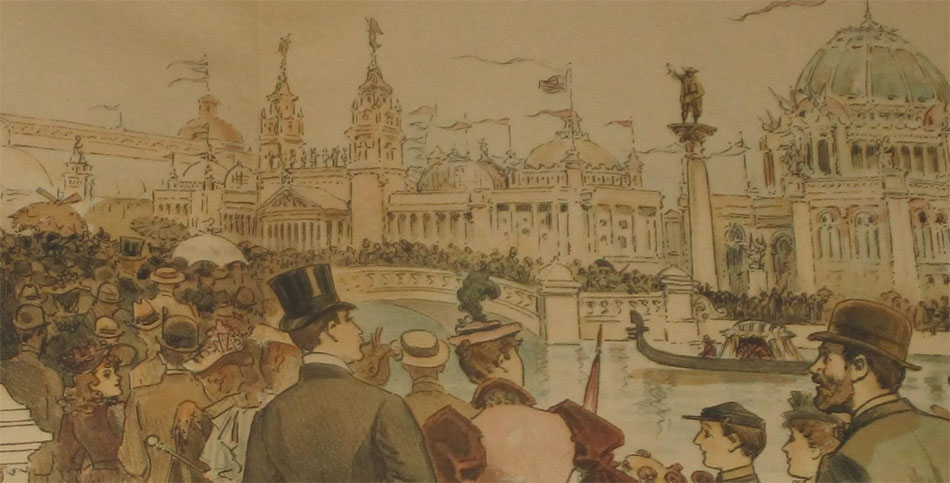
"It Will Be Opened",
Puck Lithograph 1892
"Bigotry and Intolerance
Can Not Obstruct The Progress Of Civilization-- The World's Fair Will
Be Opened On Sunday."
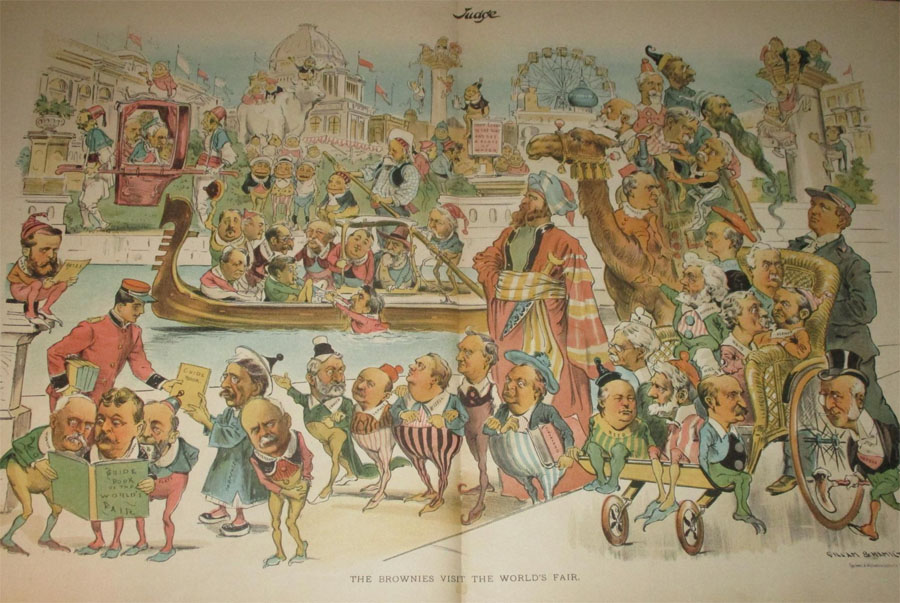
Judge, The Brownies
at the World's Fair, 1893
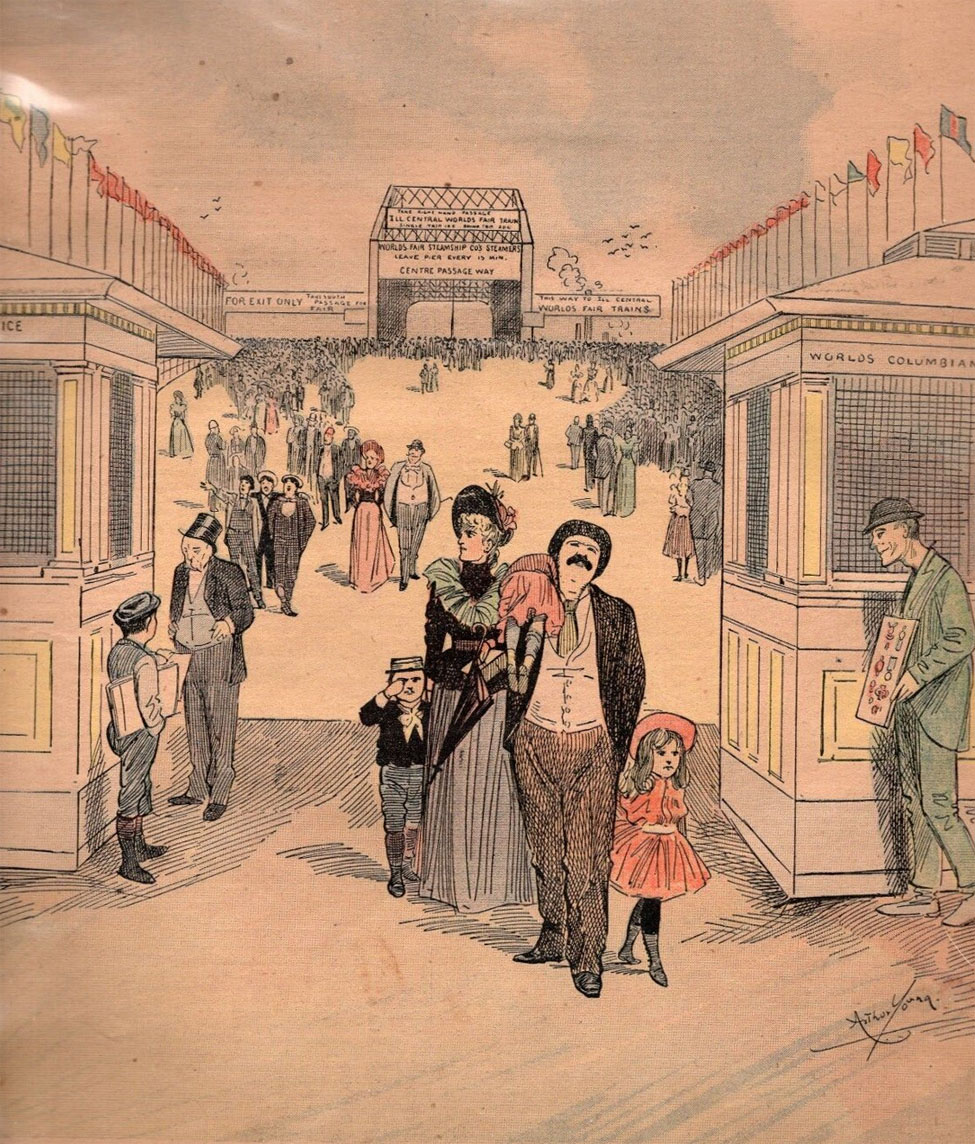
"EVENING AT THE VAN
BUREN STREET VIADUCT" by Arthur Young
A Scene at the Popular
Gateway of the Fair -- The Coming and Going of Visitors.
The Inter Ocean Illustrated
Supplement, June 14, 1893
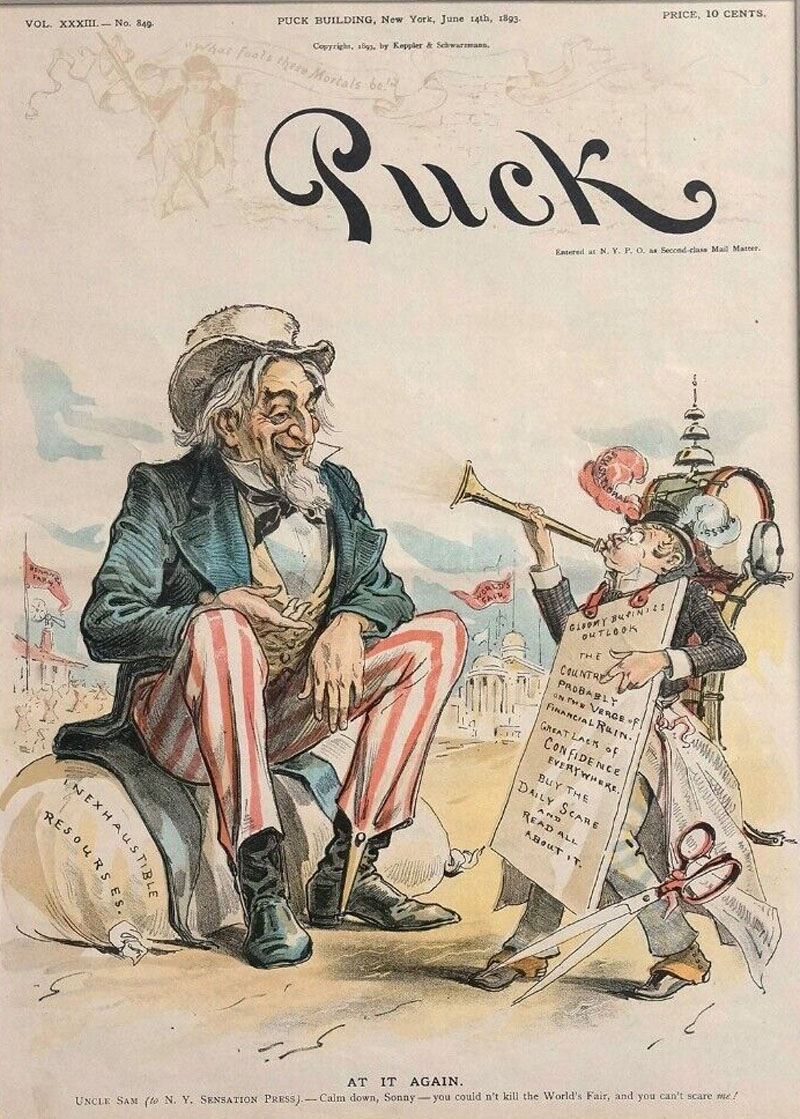
"Gloomy Business Outlook"
rejected by Uncle Sam; "you couldn't kill the World's Fair,
and you can't scare me!" Puck, June 14, 1893
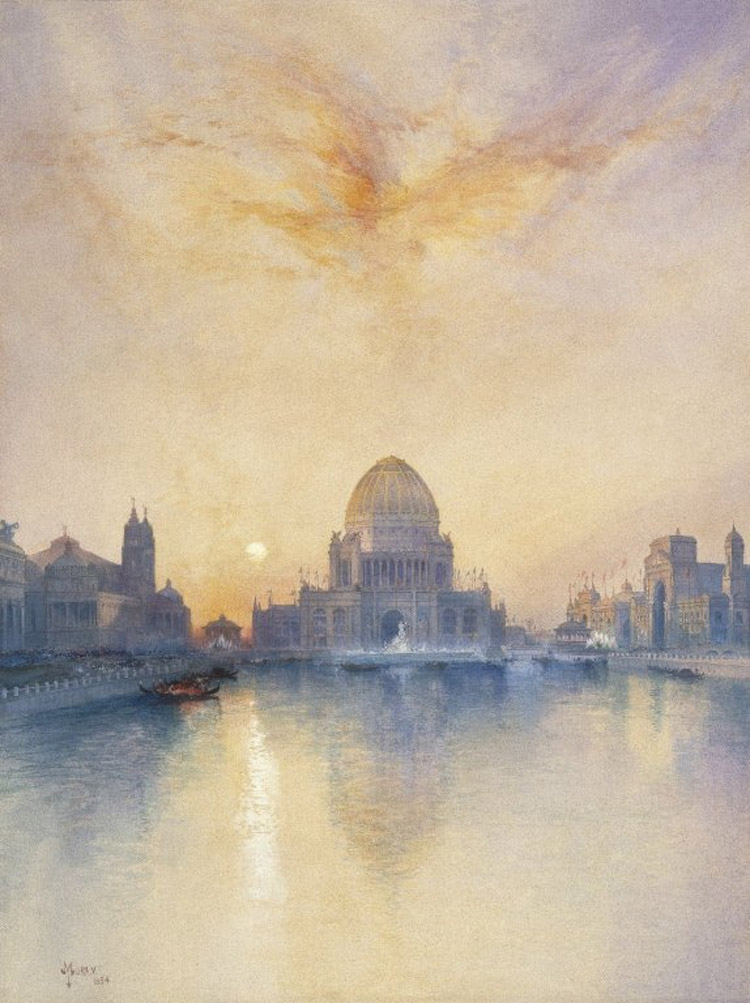
Chicago World's Fair by
Thomas Moran, 1894 (Courtesy Brooklyn Museum)
References and Links
- World's Columbian Exhibition of 1893 and the Phonograph
References,
Annotations and Endnotes for World's Columbian Exhibition of 1893
"Official
Guide to the World's Columbian Exposition in the city of Chicago,
State of Illinois, May 1 to October 26, 1893" (Souvenir Edition
by John J. Flinn, Chicago, 1893)
"Official
Guide to the World's Columbian Exposition in the city of Chicago,
State of Illinois, May 1 to October 26, 1893" (Handbook Edition
by John J. Flinn, Chicago, 1893)
"Official
guide to Midway Plaisance" by John J. Flinn, Chicago, 1893
(Library
of Congress)
Official
Guide to the World's Columbian Exposition
The
Electricity Building at the World's Columbian Exhibition of 1893
Chicago
Postcard Museum to "see the complete set of 12 (series
No. 1) Official 1893 Chicago World's Columbian Exposition postal cards
PBS
American Experience - The Columbian Exposition from Tesla
The
Edison Electric Tower - An illustration of the Tower by R. Outcault
and other Connections
Pope
Leo XIII Sends Greetings to American People by means of Edison's Phonograph
For examples of Uncle Sam's presence
at the 1893 Chicago World's Fair see Uncle
Sam and the World's Columbian Exposition of 1893.
Kinetograph
Reference Material
and Links
The
World's Columbian Exposition of 1893 and the Kinetograph - Details
related to the Kinetograph/Kinetoscope as an exhibit
References,
Annotations and Endnotes for the Kinetoscope at The World's Columbian
Exposition of 1893
American
Society of Cinematographers for overview of the Kinetoscope and
their restored Kinetoscope
Blacksmithing
Scene - Edison Kinetograph Film, 1893 (Courtesy MOMA)
Blacksmithing Scene - MOMA
Learning
Scientific
American, May 20, 1893 - Report on the Kinetograph's first
public demonstration at the Brooklyn
Institute of Arts and Sciences on May 9, 1893
Edison
and the Kinetoscope: 1888-1895, Musser, Charles. "Before
the Nickelodeon: Edwin S. Porter and the Edison Manufacturing Company."
Berkeley: University of California Press, ©1991
Kinetoscope-
Wikipedia

Phonographia
|



